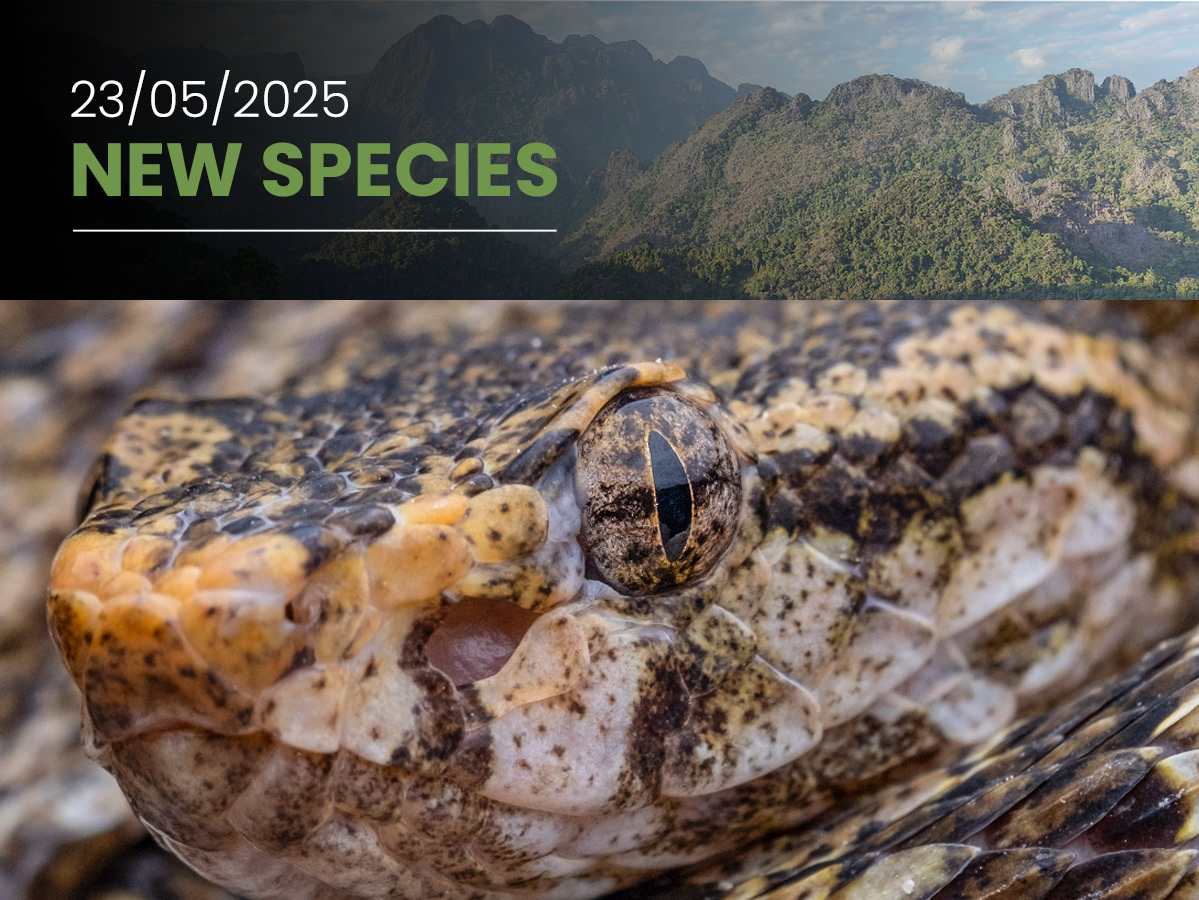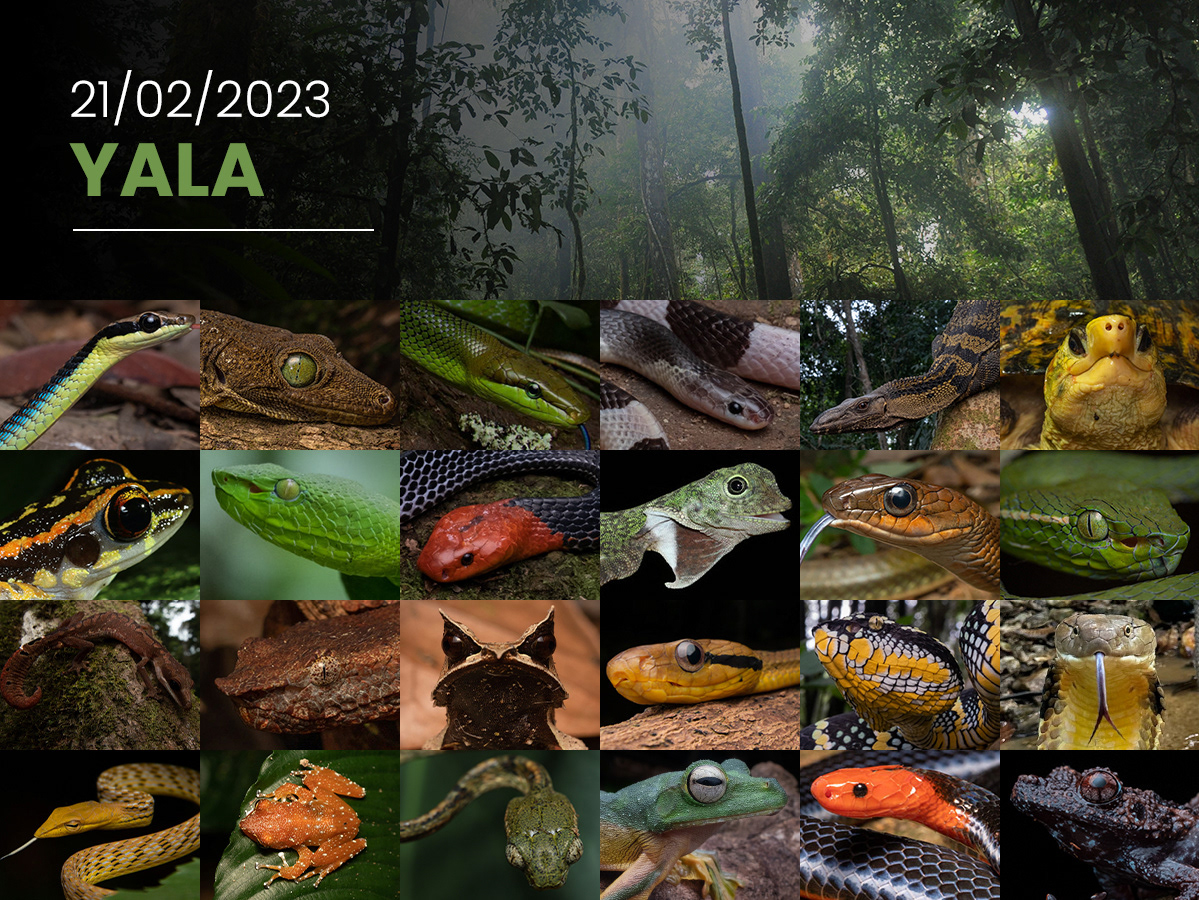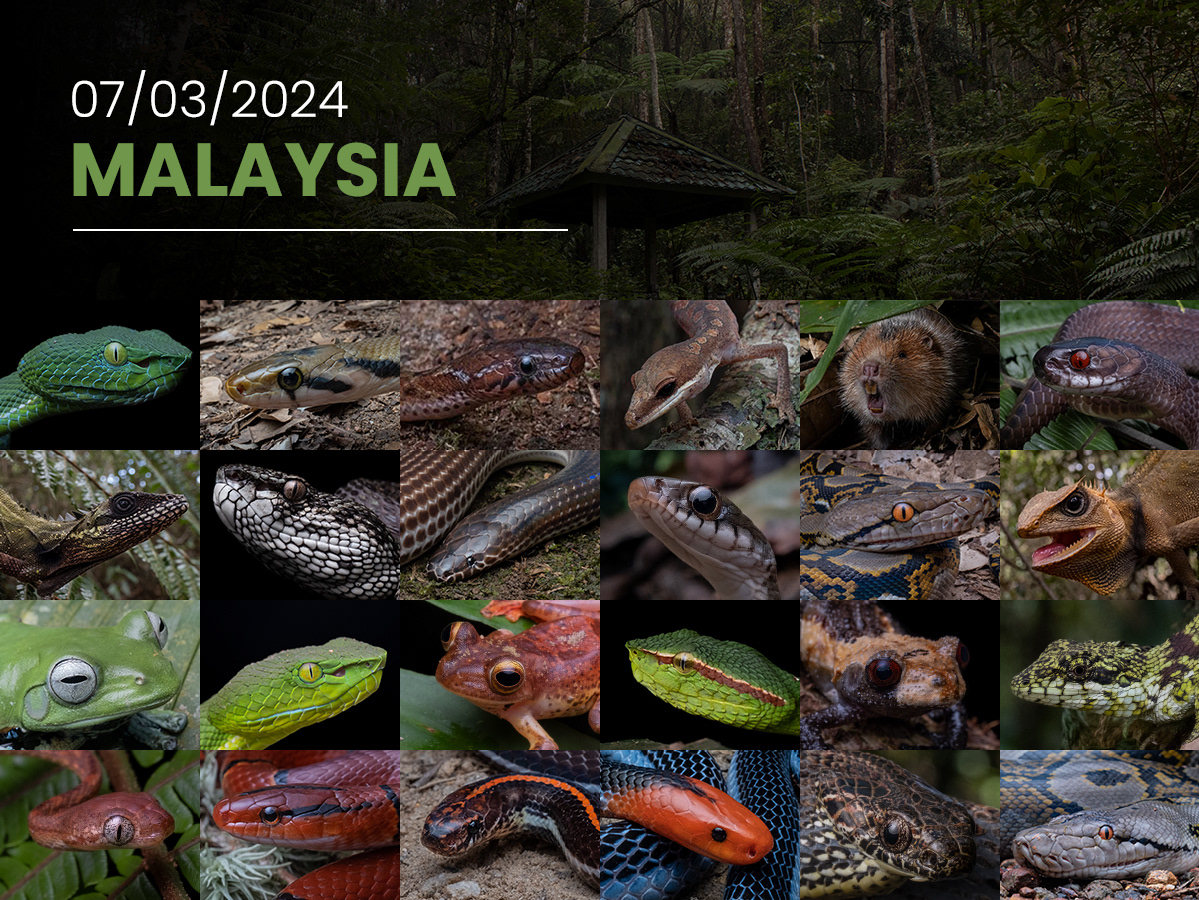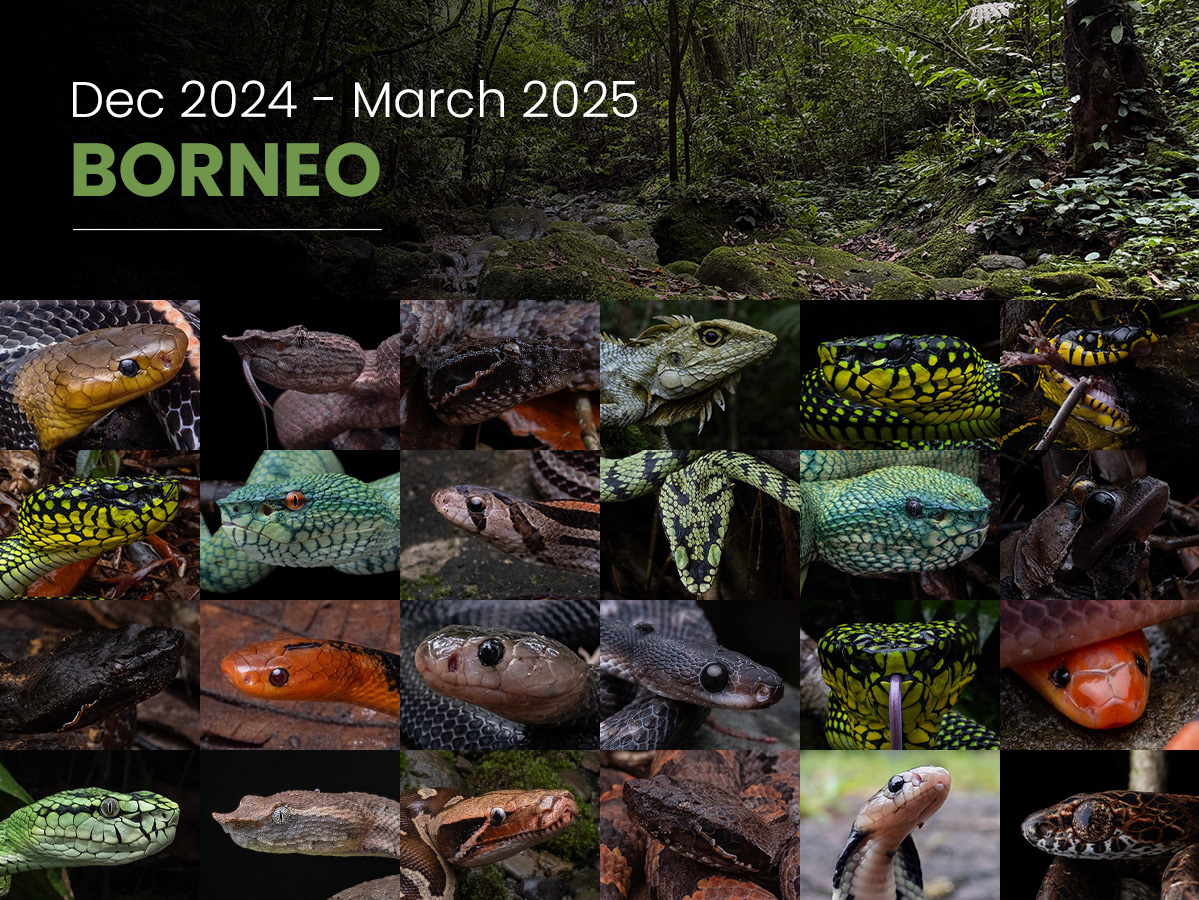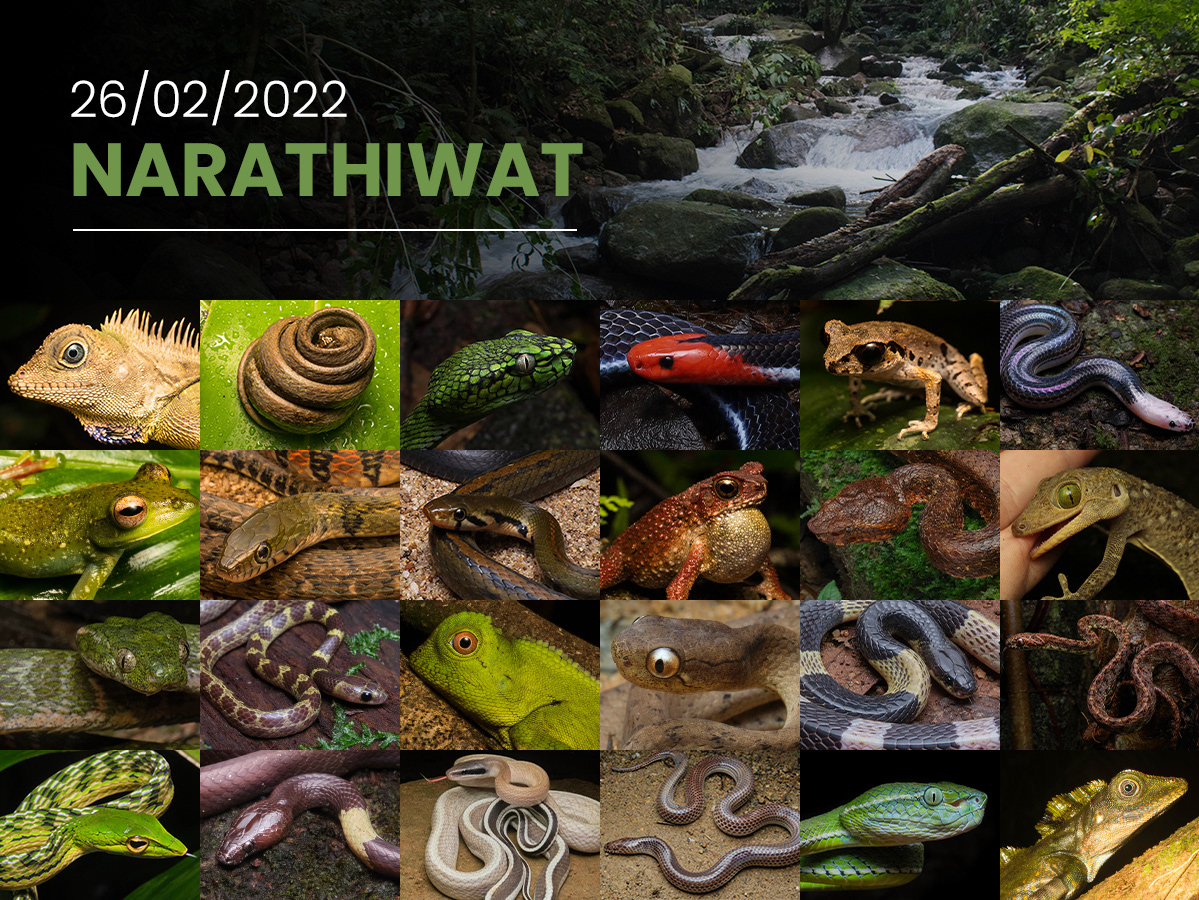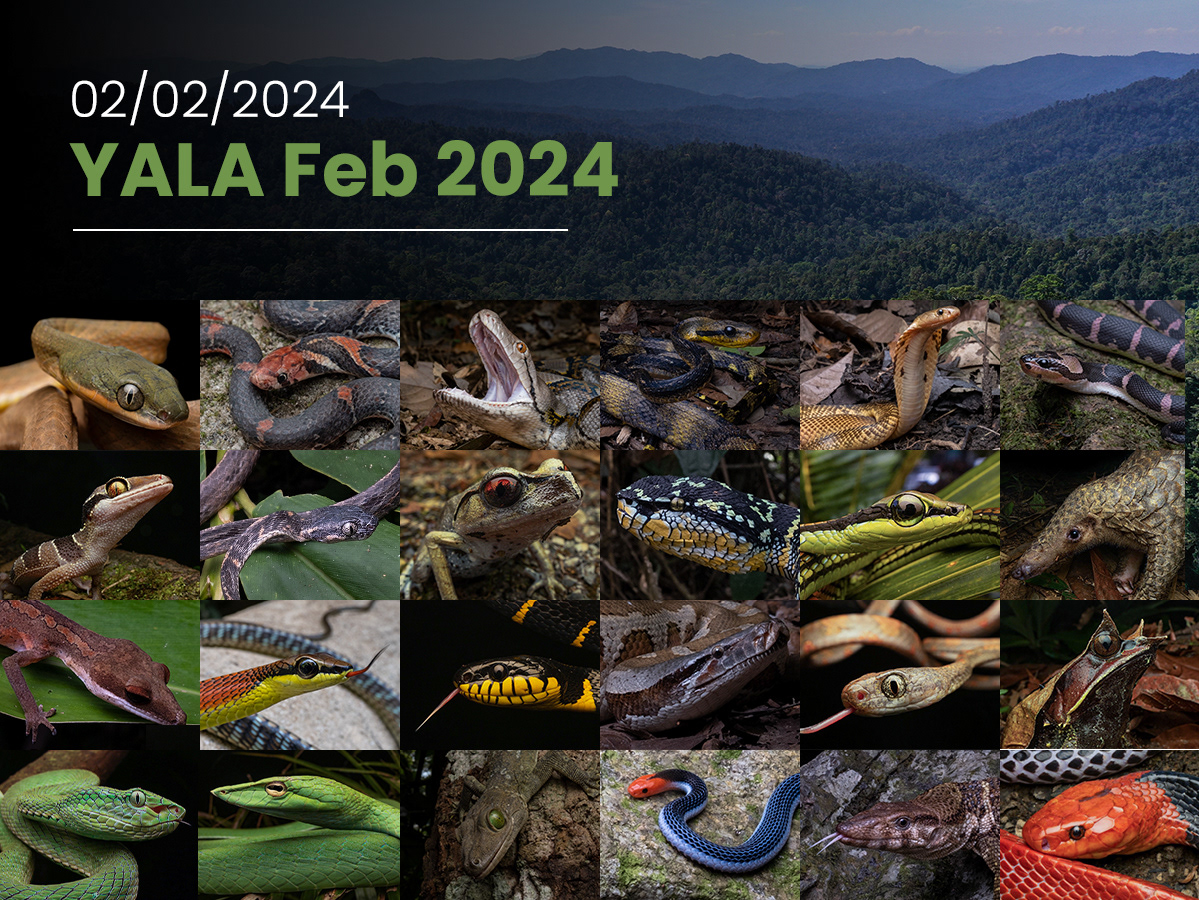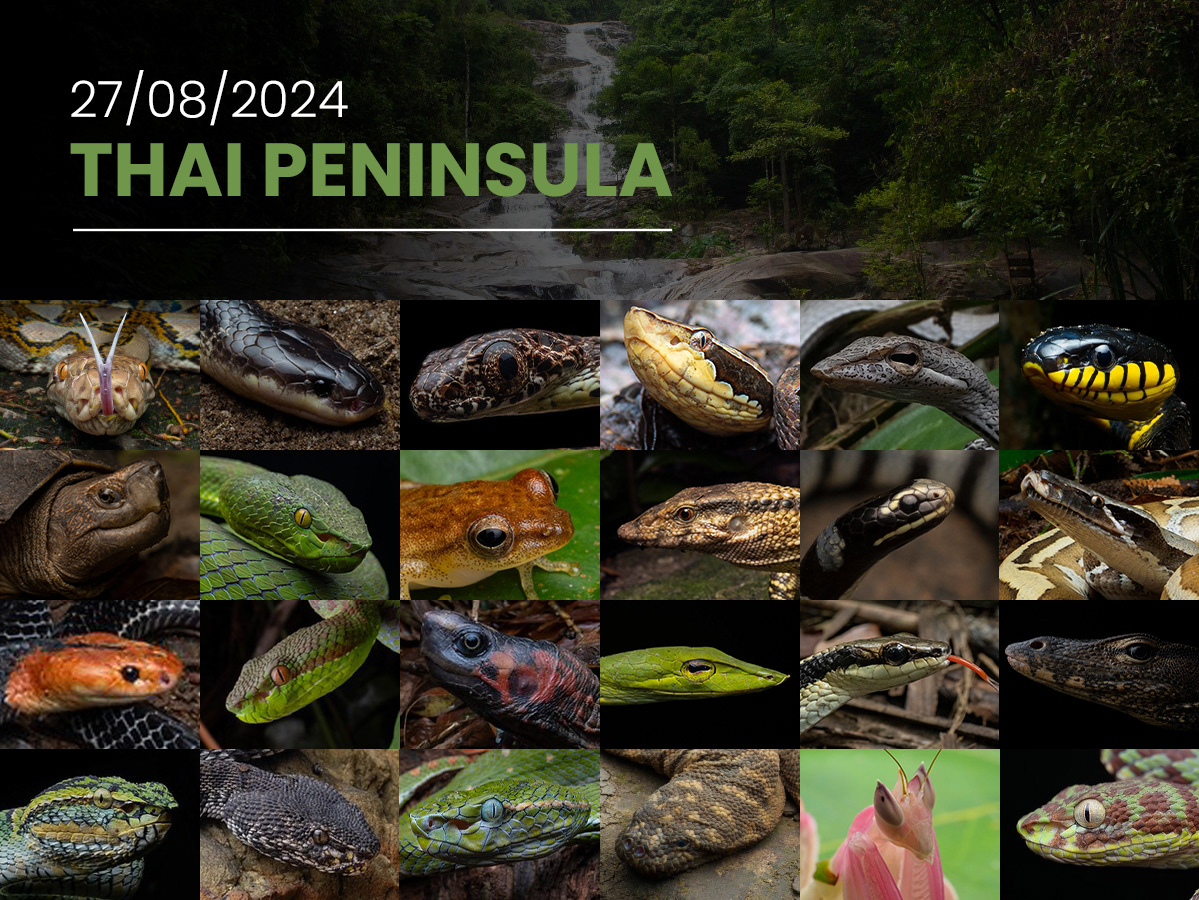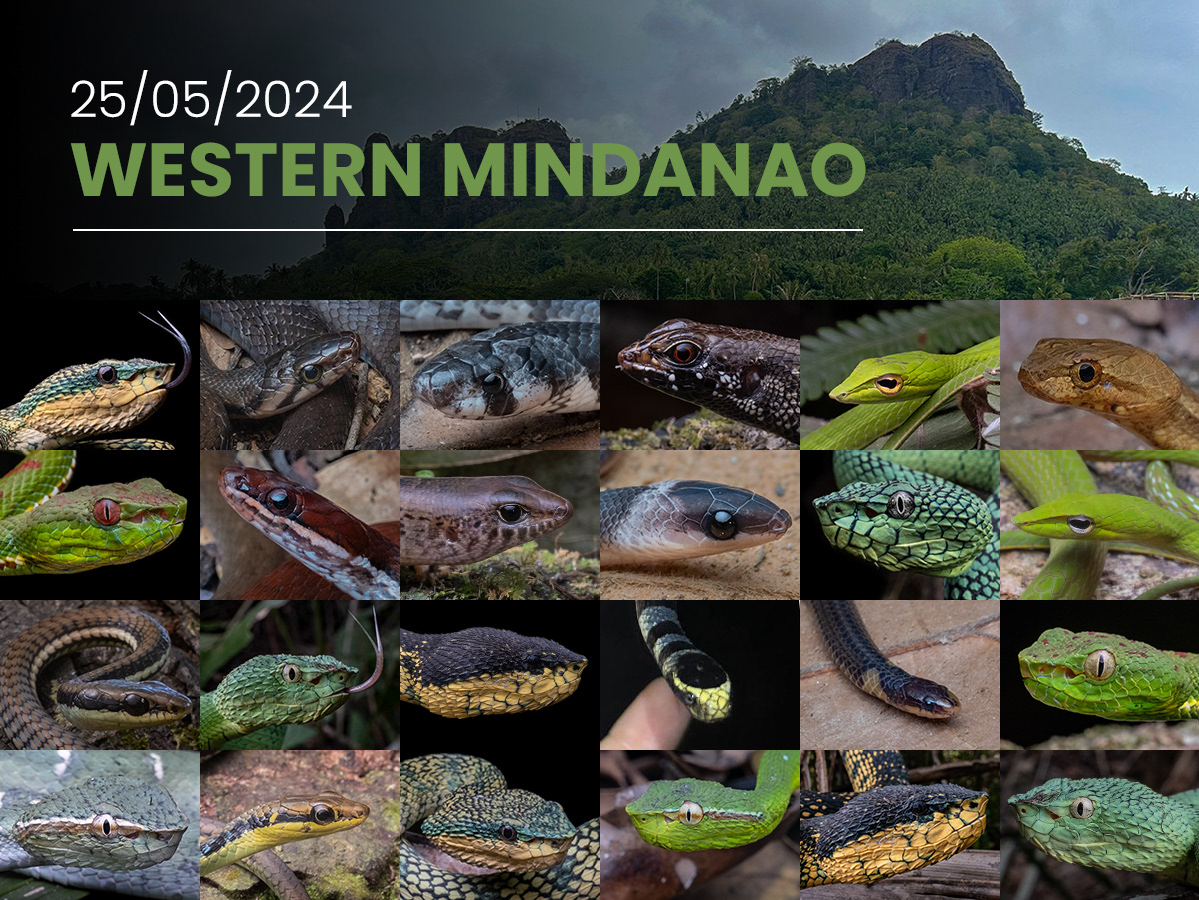Explore Herpetology’s very first scheduled expedition was an ambitious expedition to Narathiwat province. Thailand’s Deep South would not be your typical choice for a serious group trip, as western insurance companies do not cover individuals visiting the area, the area is extremely remote and the incessant rain is unwelcoming. However, we desired to live up to our name and bring people to the frontier of herpetology in Thailand - somewhere almost impossible to travel to and successfully herp without extensive experience. Our team had been on multiple trips to the area in the past, and consider it to be the most biodiverse and productive herping location in South-East Asia. Sharing it with other enthusiastic people would be a pleasure.
On the 1st August, we met everyone in Trang province and after a brief introductory talk on safety, significant species and the plan for the following week, it was time to prepare for the first night in the forest.
We ventured into Trang’s evergreen lowland rainforest after a day of non-stop rain, and the environment felt primed for a productive night of herping (albeit with many leeches active). Seconds after arriving at our location, Callum (our only guest who had never been ‘herping’ before) found the first snake of the trip, a white-spotted cat snake (Boiga drapiezii).
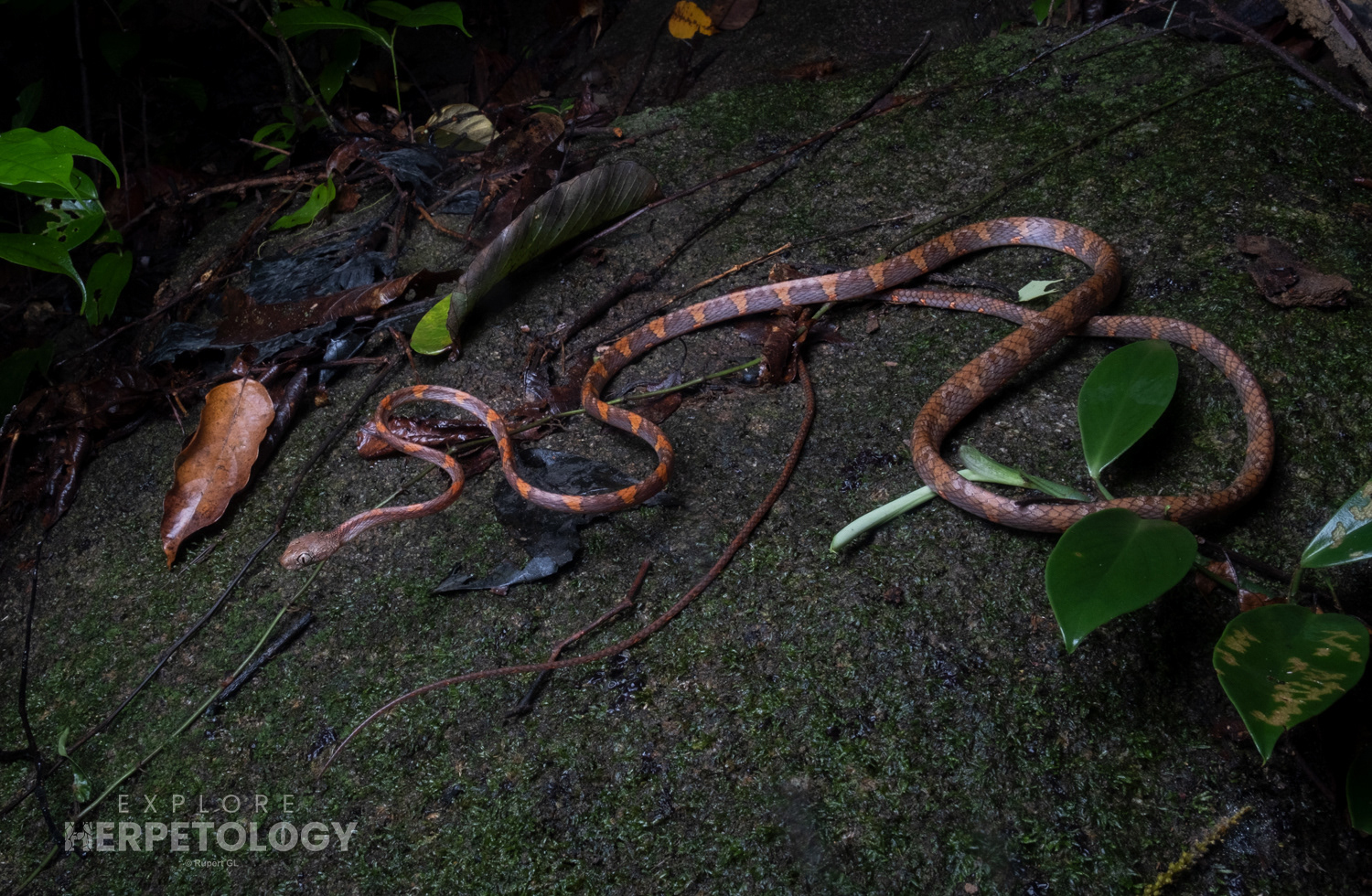
White-spotted cat snake (Boiga drapiezii)
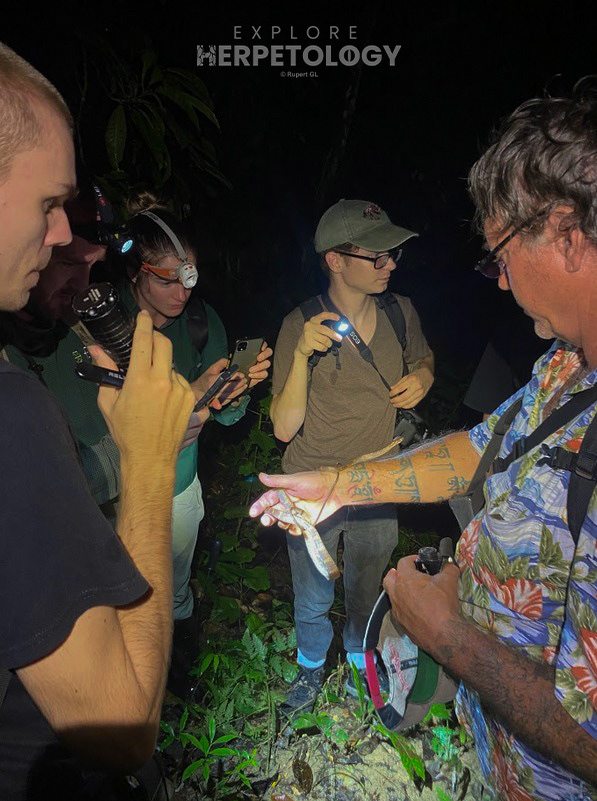
Enjoying the first snake of the trip.
Following this was an evening which nobody expected. In just a few hours hiking, we saw an impressive 20 further snakes across 9 species. In total we saw 2 white-spotted cat snakes (Boiga drapiezii), 2 blunt-headed slug snakes (Aplopeltura boa), 2 dark-headed cat snakes (Boiga nigriceps), 2 keeled slug snakes (Pareas carinatus), 7 Bengkulu cat snakes (Boiga bengkuluensis), 2 Thai peninsula pit-vipers (Trimeresurus sabahi), 2 white-bellied rat snakes (Ptyas fusca), as well as an elegant bronzeback (Dendrelaphis formosus) and a Malayan banded wolf snake (Lycodon subcinctus).
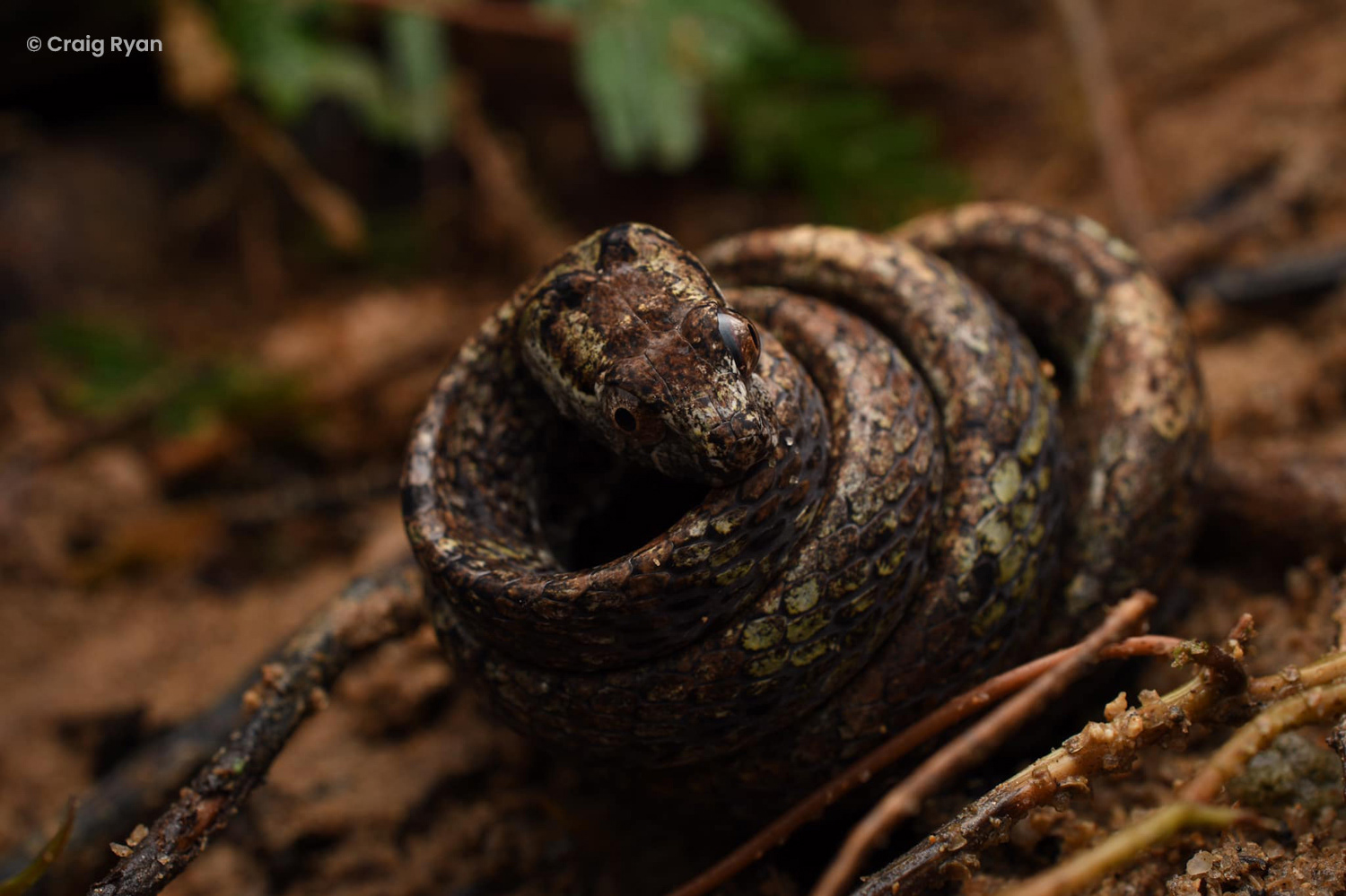
Blunt-headed slug snake (Aplopeltura boa)

Juvenile dark-headed cat snake (Boiga nigriceps).
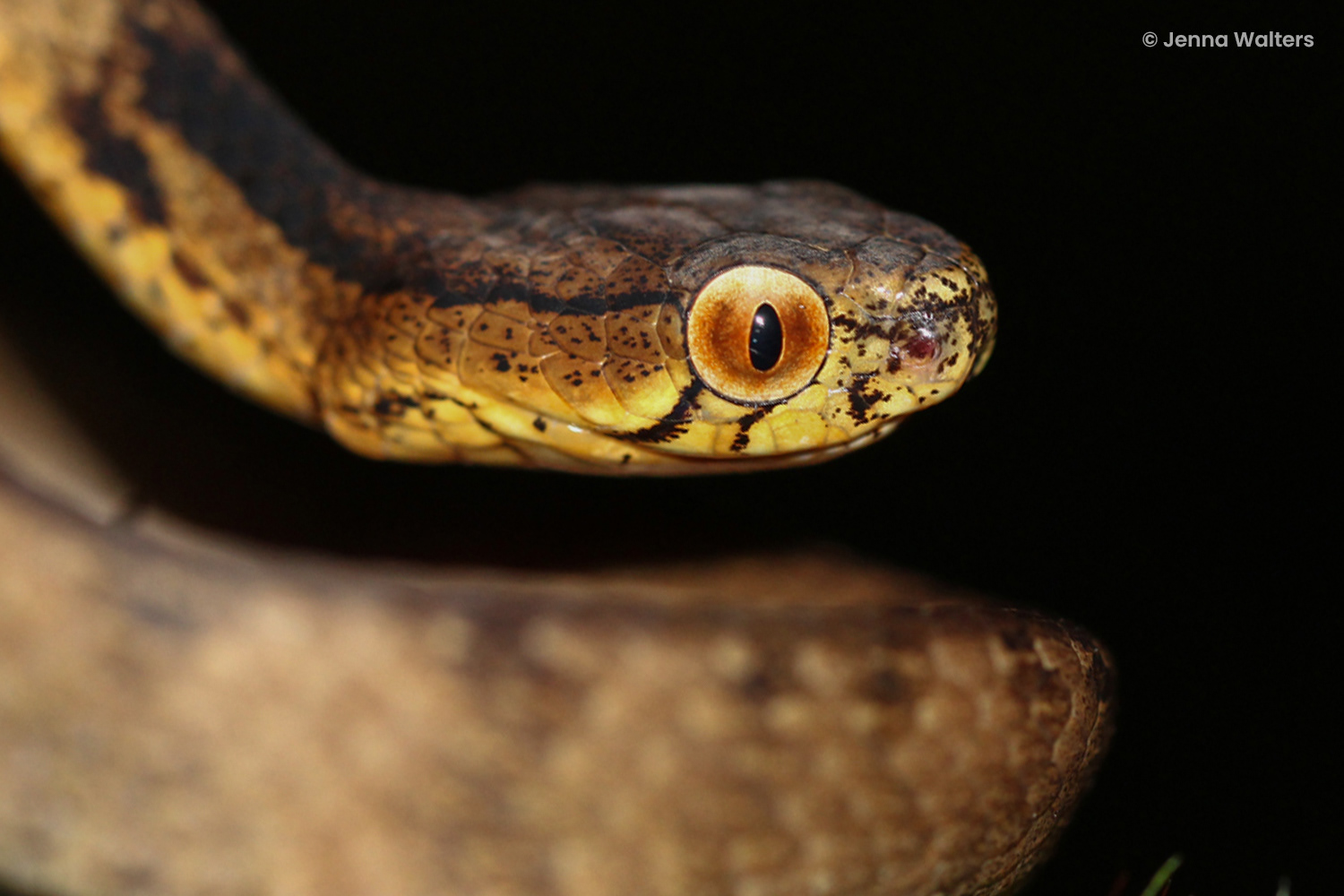
Keeled slug snake (Pareas carinatus).
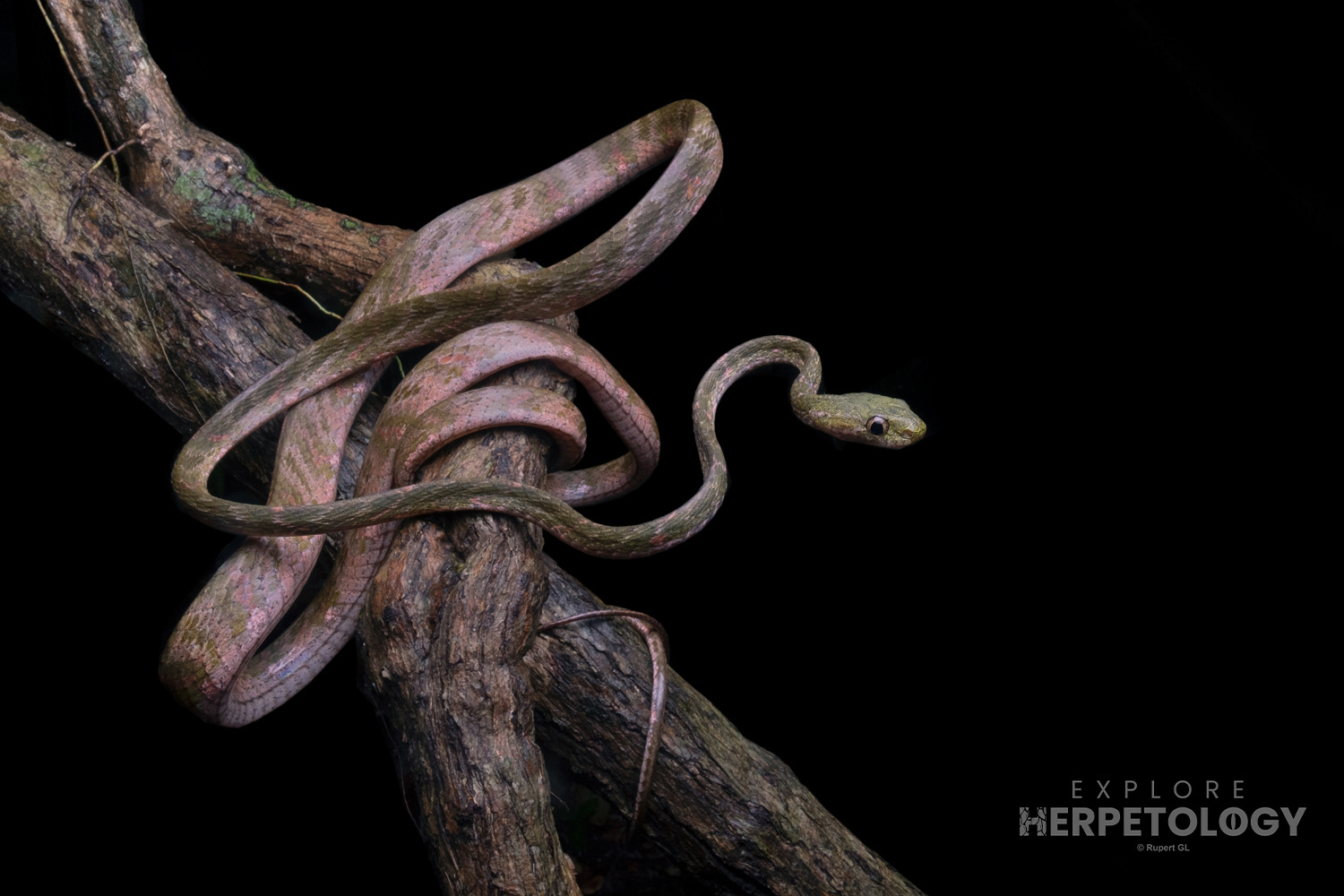
Bengkuku cat snake (Boiga bengkuluensis).
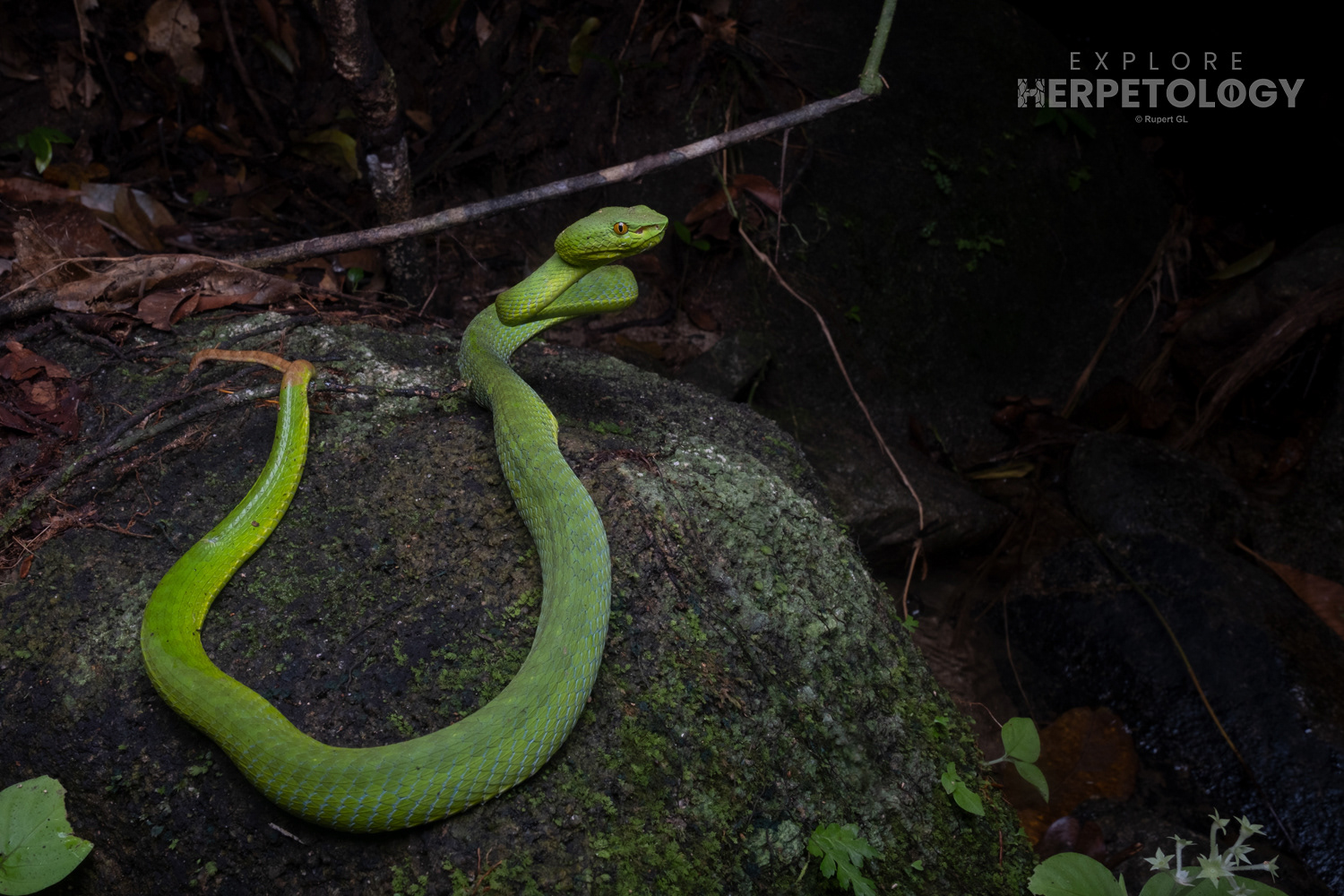
Siamese peninsula pit viper (Trimeresurus sabahi/fucatus).
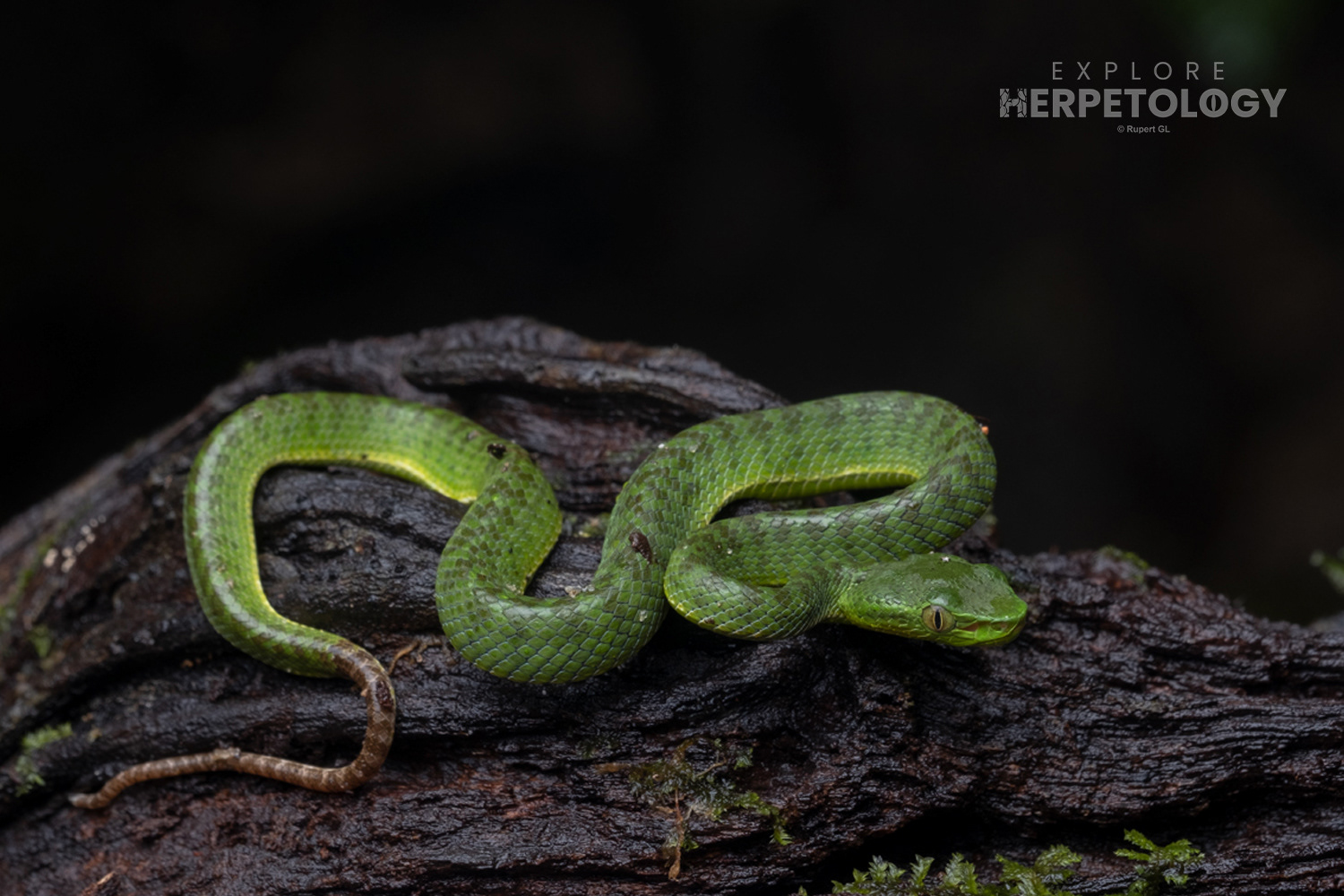
Juvenile Siamese peninsula pit viper (Trimeresurus sabahi/fucatus).
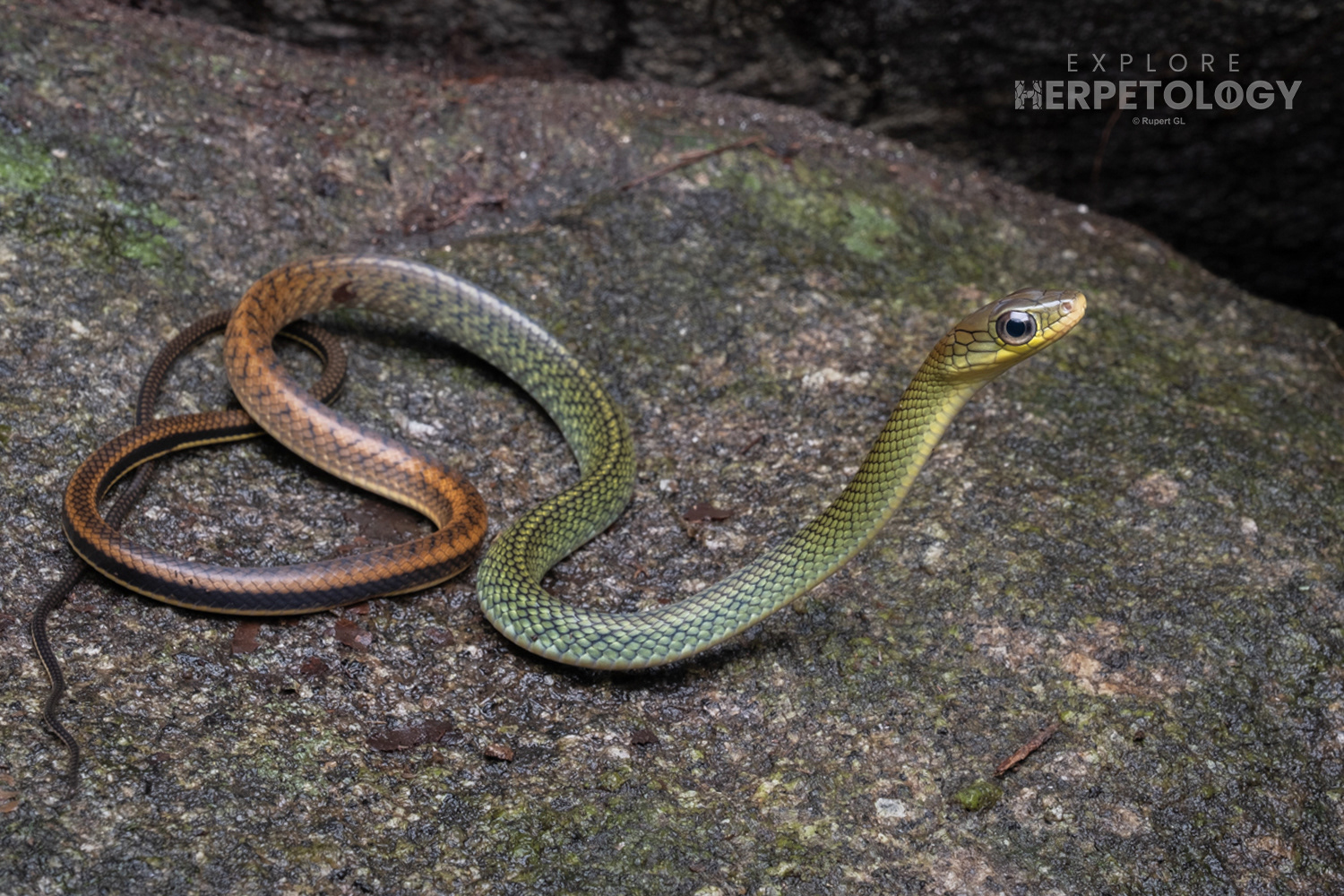
Juvenile white-bellied rat snake (Ptyas fusca).
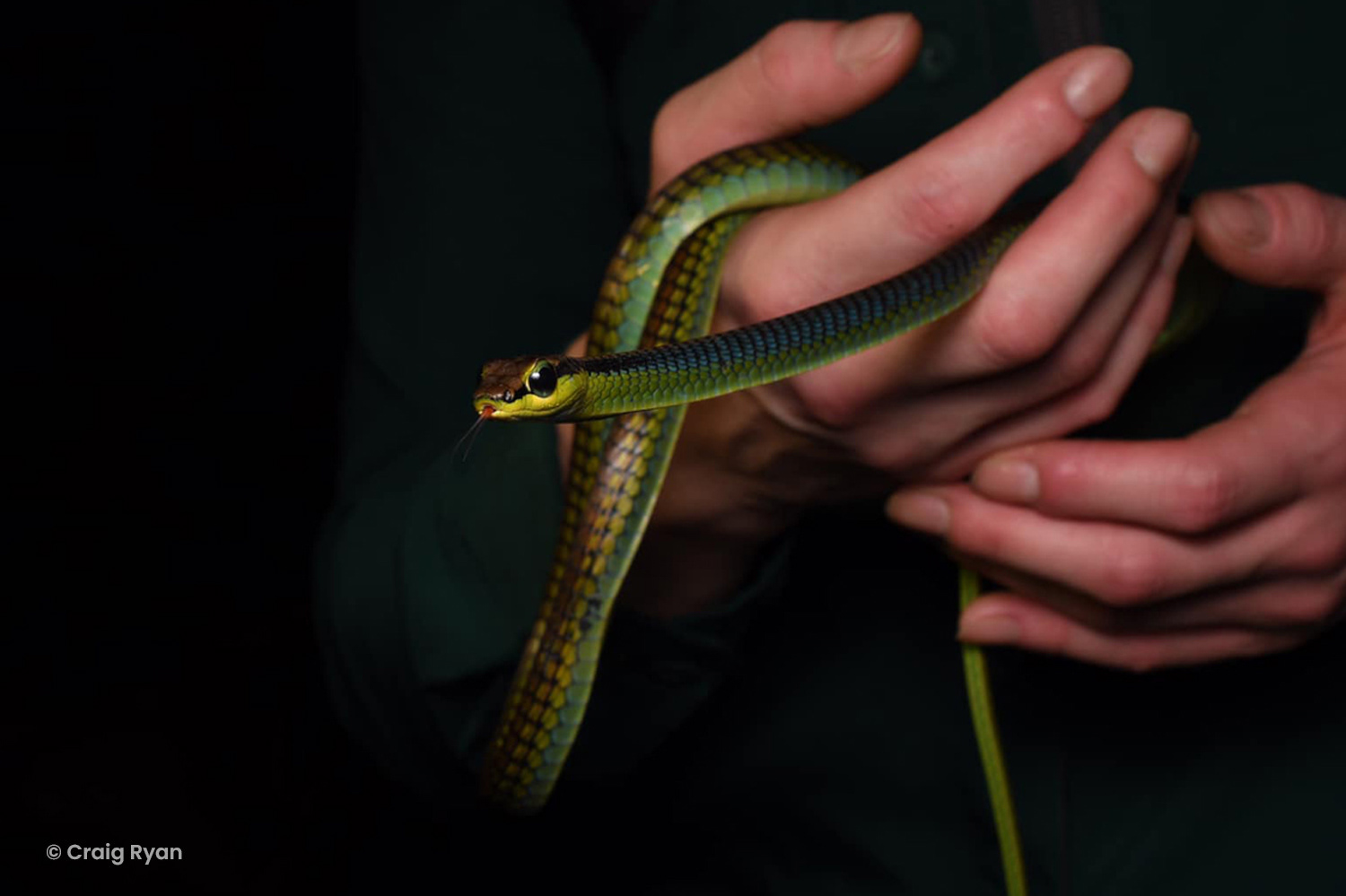
Elegant bronzeback (Dendrelaphis formosa).

Juvenile Malayan banded wolf snake (Lycodon subcinctus).
The following morning, we rose early and began the 6 hour drive south to our accommodation in Narathiwat province, the flagship location of the expedition.
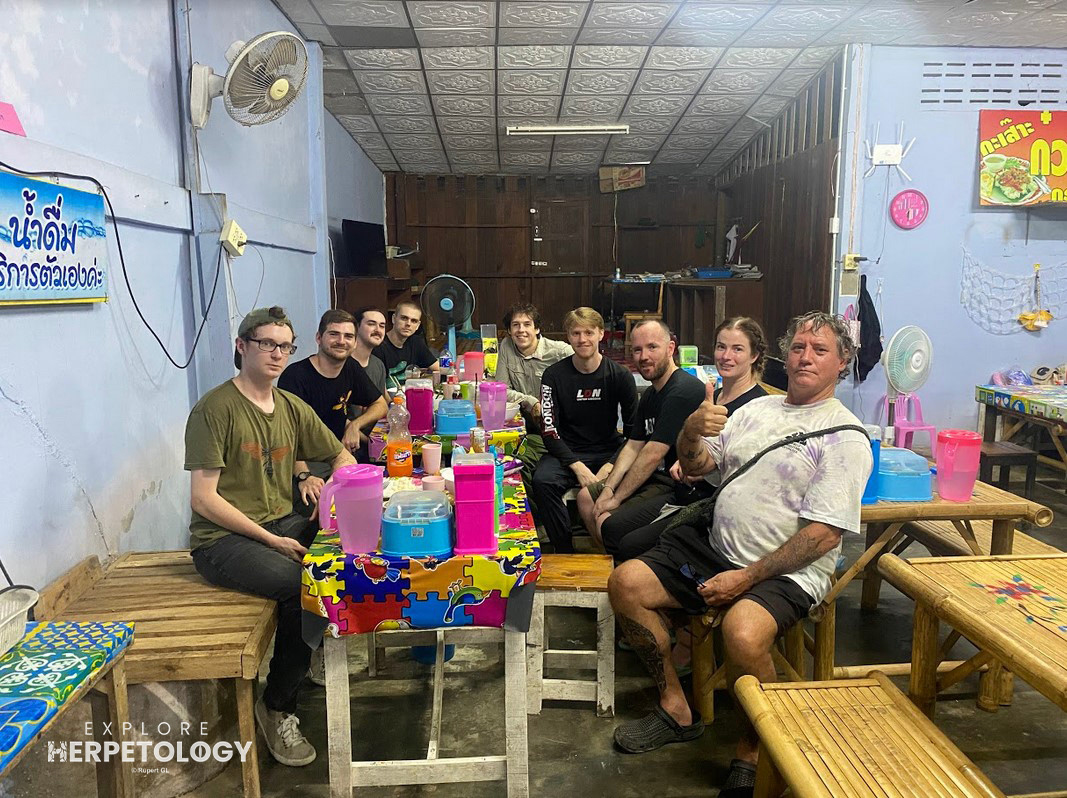
The first supper! (in Narathiwat)
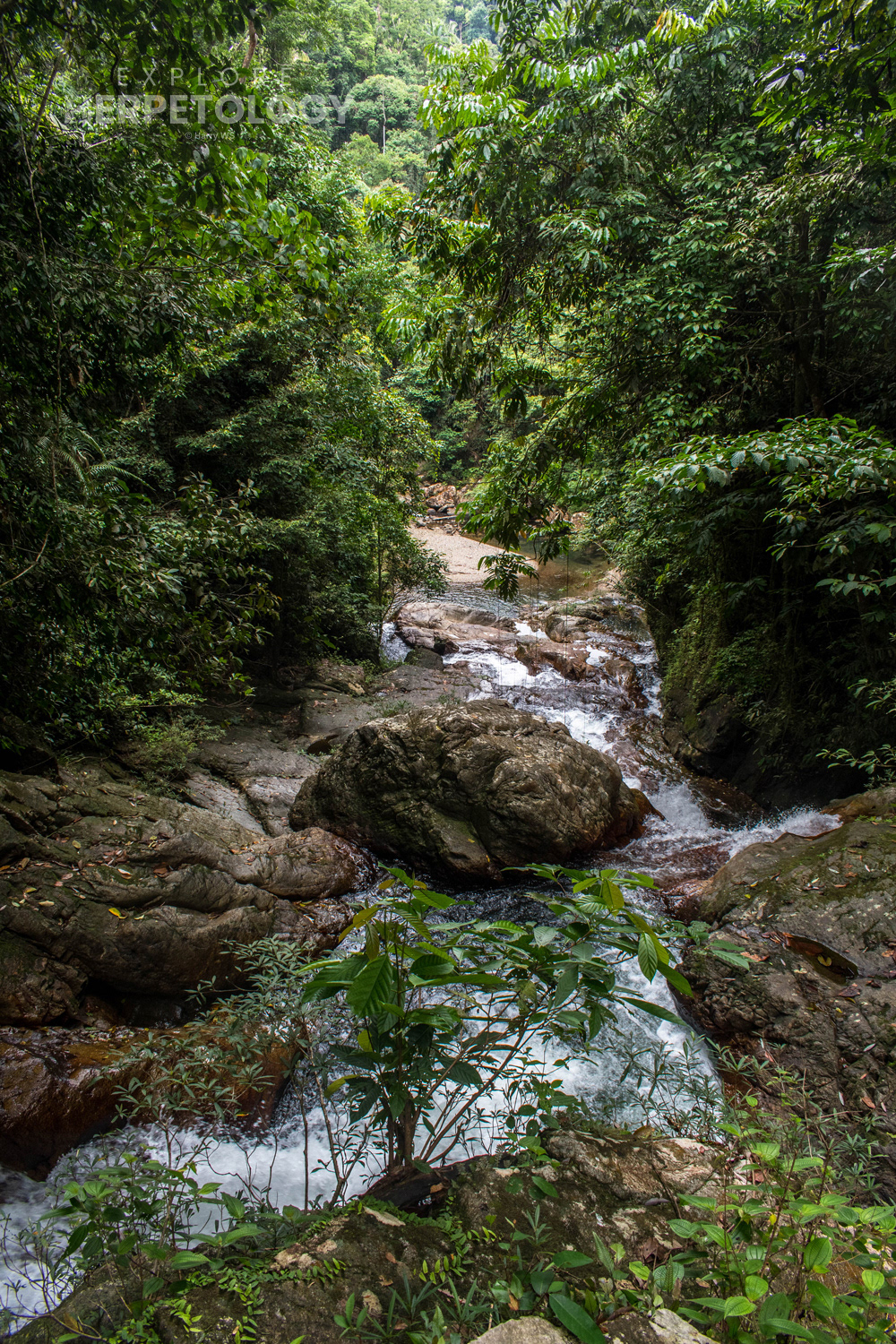
The hunting grounds.
Our evening walk in the forest beside our accommodation was delayed 30 minutes by some extremely heavy rain, but once the rain subsided we were treated to another legendary night of herping, beginning with back to back nocturnally active red-tailed racer (Gonyosoma oxycephalum) observations, presumably disturbed by the rain as they were about to rest for the night.
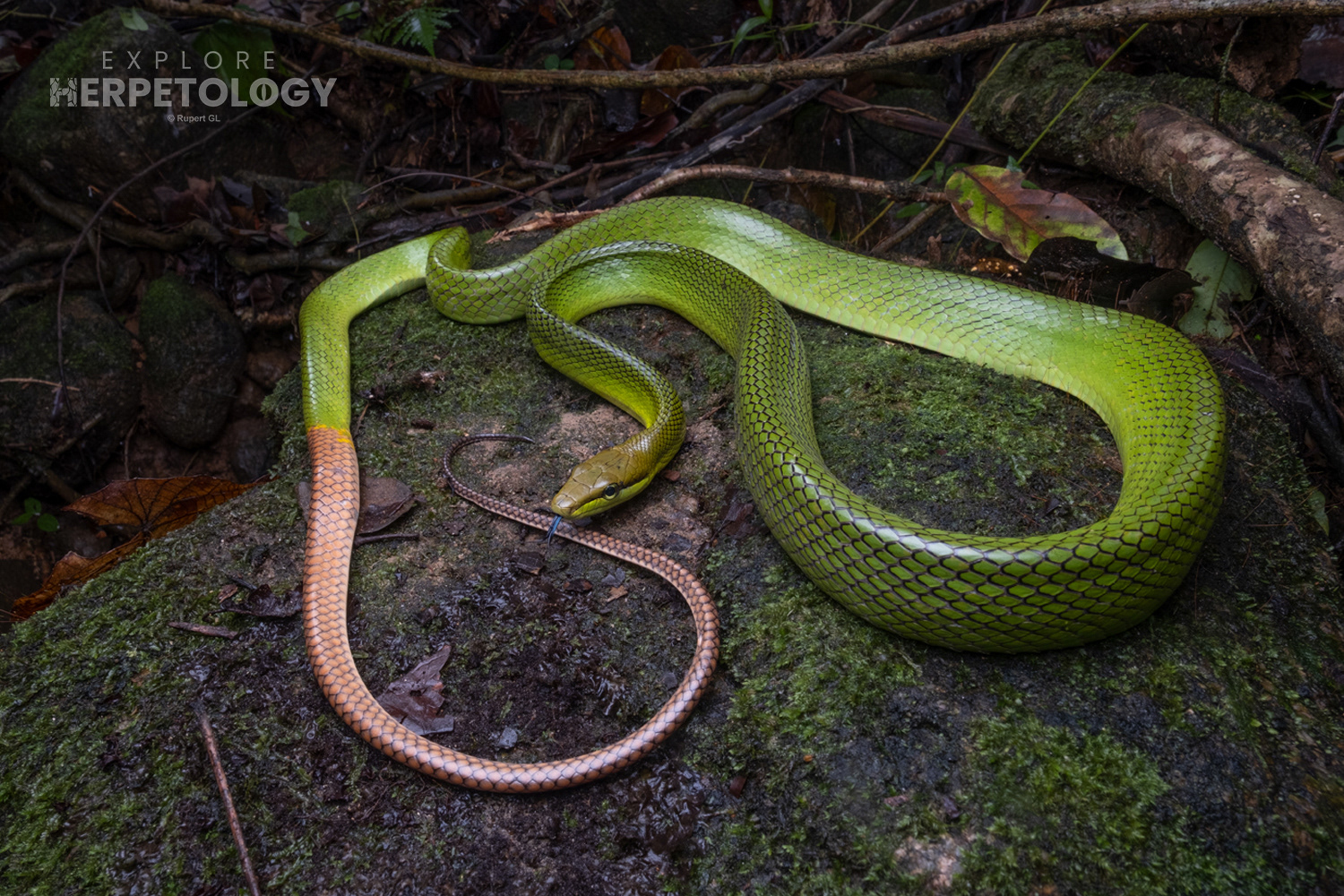
Red-tailed racer (Gonyosoma oxycephalum).
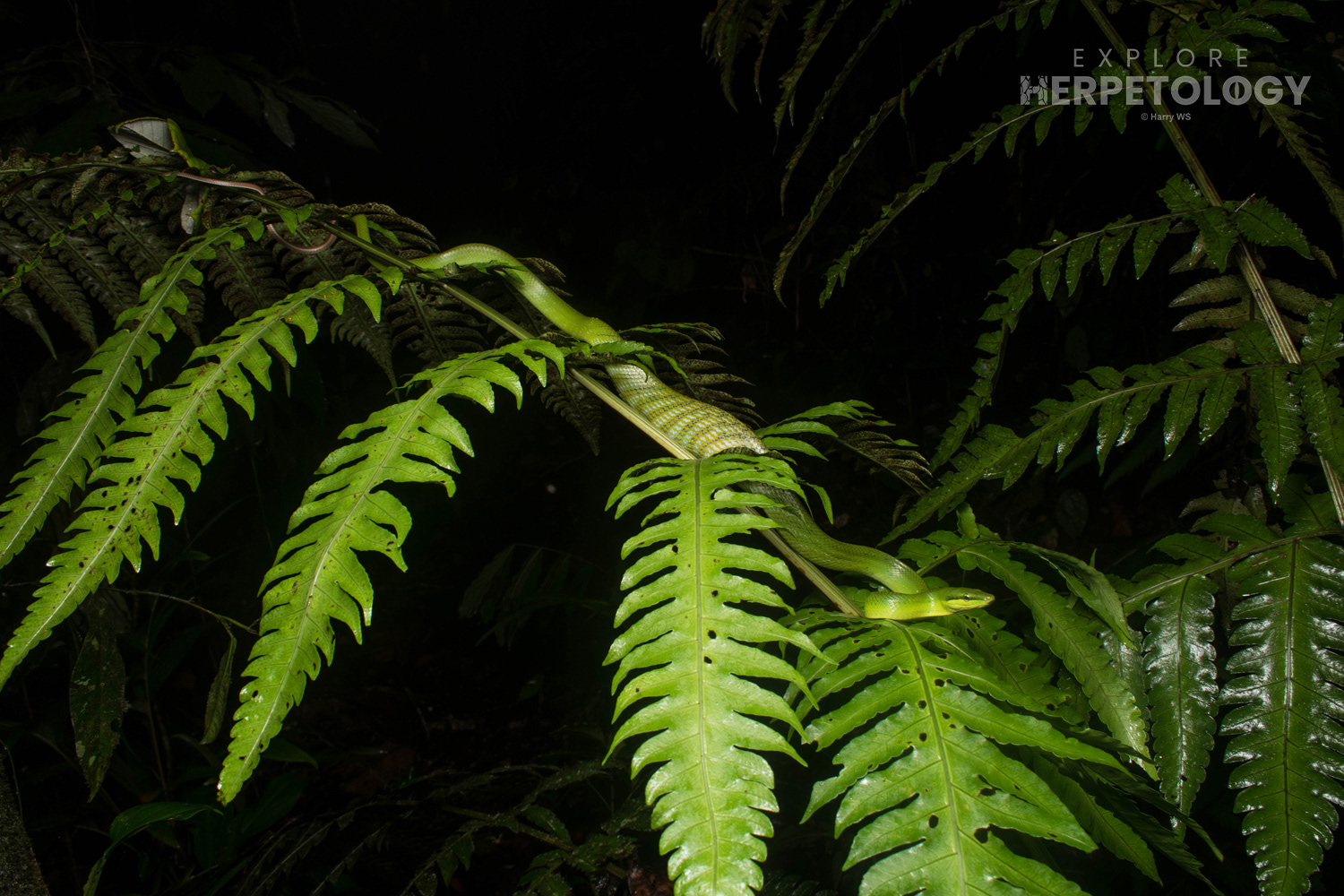
The second red-tailed racer (Gonyosoma oxycephalum) with a hefty meal.
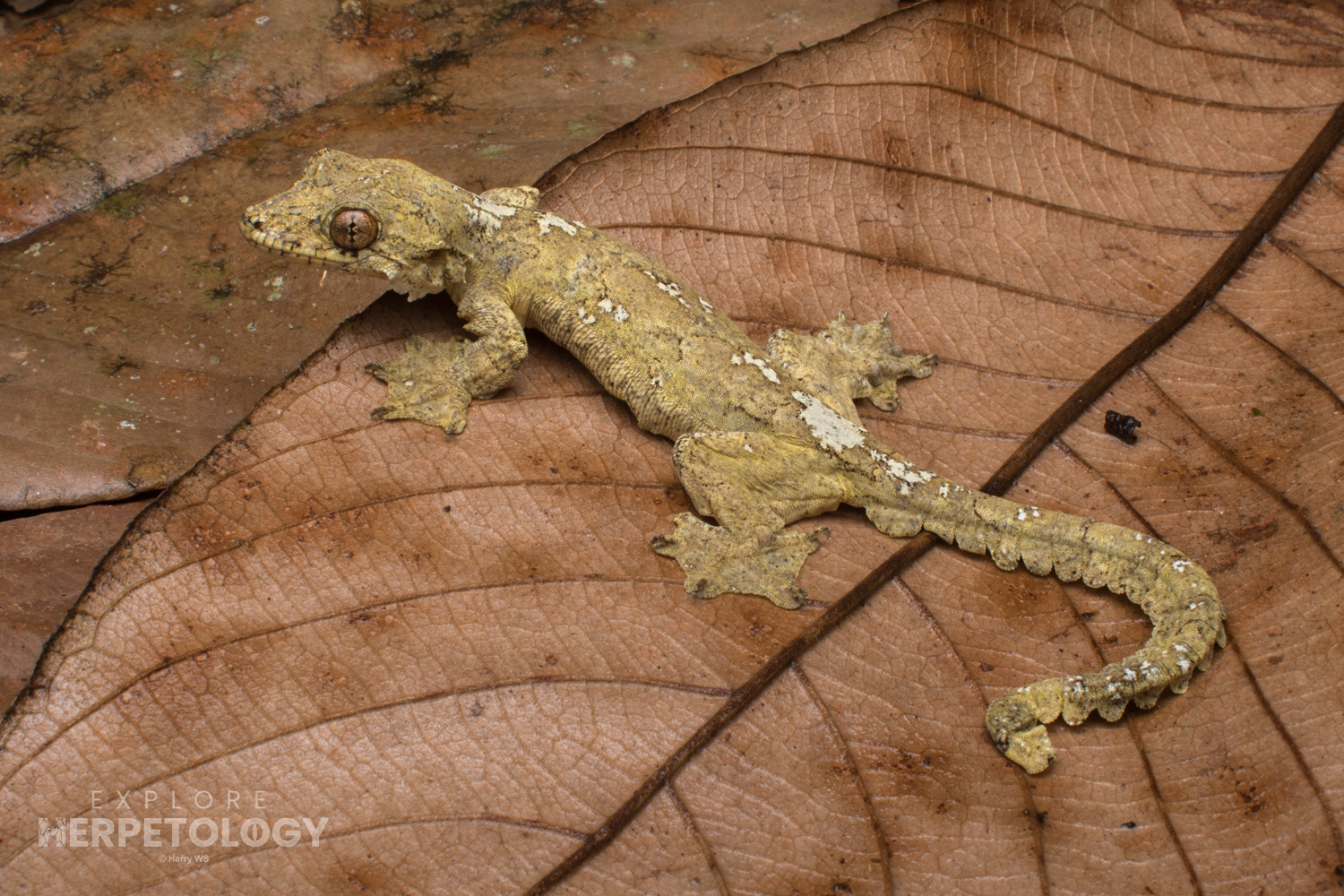
Malaysian gliding gecko (Gekko cicakterbang)
Following this were a few of the more predictable sightings, including 2 dark-headed cat snakes (Boiga nigriceps), a juvenile Hagen’s pit-viper (Trimeresurus hageni) and a Malayan vine snake (Ahaetulla mycterizans).

Dark-headed cat snake (Boiga nigriceps)
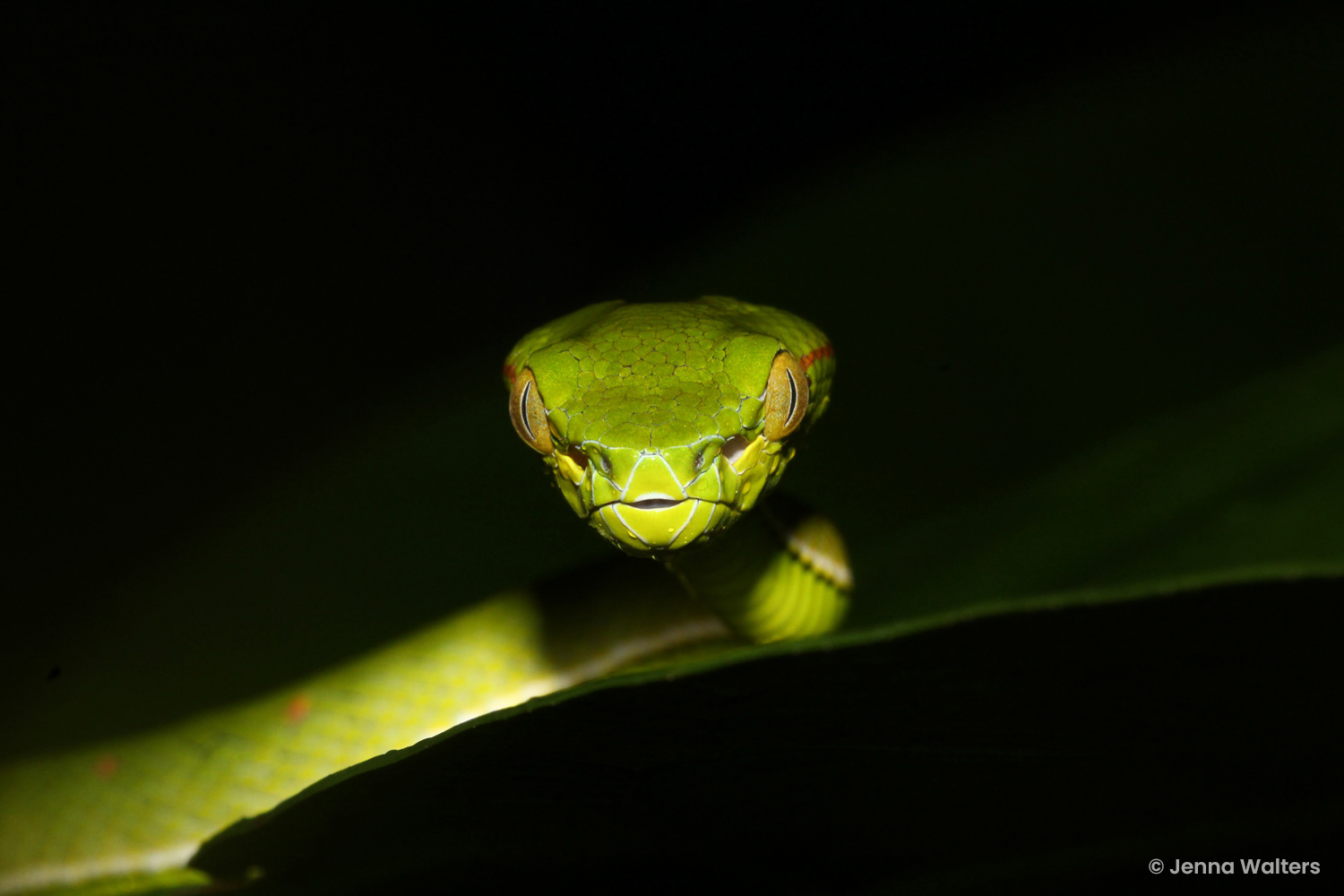
Juvenile Hagen's pit viper (Trimeresurus hageni).
In a country with some many incredible and iconic species, it is difficult to say what was the number 1 target of the trip. However, amongst the conversations I’d had with our 6 guests by this point, the blue coral snake (Calliophis bivirgata) stood out as the frontrunner. Having had great success finding this elusive species so far this year, I’d suggested a bullish 50% chance of seeing one during this trip, so not even I could have predicted finding one on the first night. Sure enough, cruising through some roots near the stream we were hiking was a little blue coral (Calliophis bivirgata).

Malaysian blue coral snake (Calliophis bivirgata flaviceps)
We could have wrapped the night up then and there, but as the group were aweing over the coral snake, I walked a few meters upstream and spotted another snake periscoping on a rock. Upon closer inspection, I realised it was a young female Wirot’s pit-viper (Craspedocephalus wiroti), another unbelievable encounter. From here, the night became a Wirot’s pit-viper frenzy. We found 2 juvenile males and then a monstrous female, similarly sized to our gargantuan adult found back in March. This was a fantastic welcome to Narathiwat, despite hugely undermining my earlier comments about how rare they are.
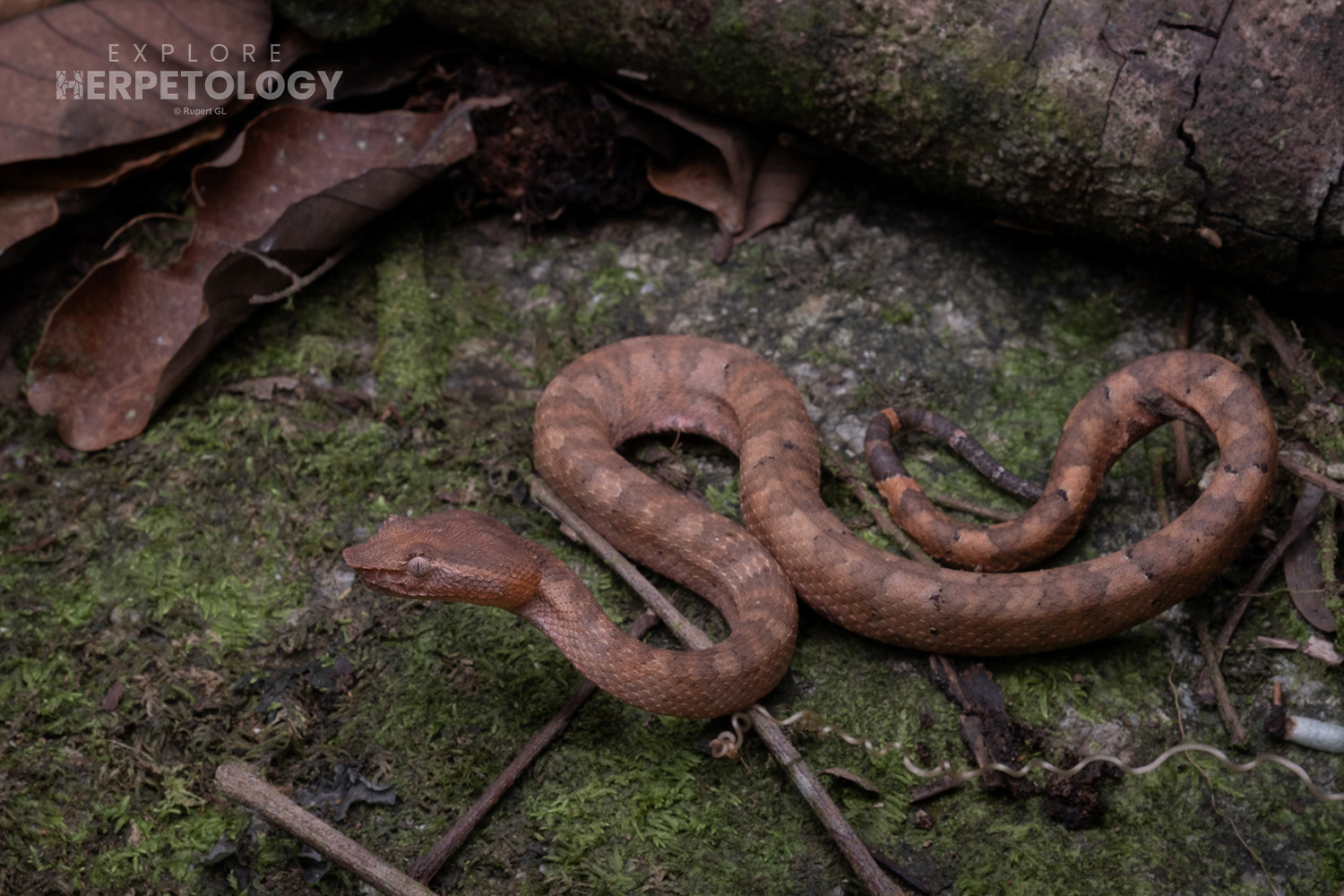
Subadult female Wirot's pit viper (Craspedocephalus wiroti).
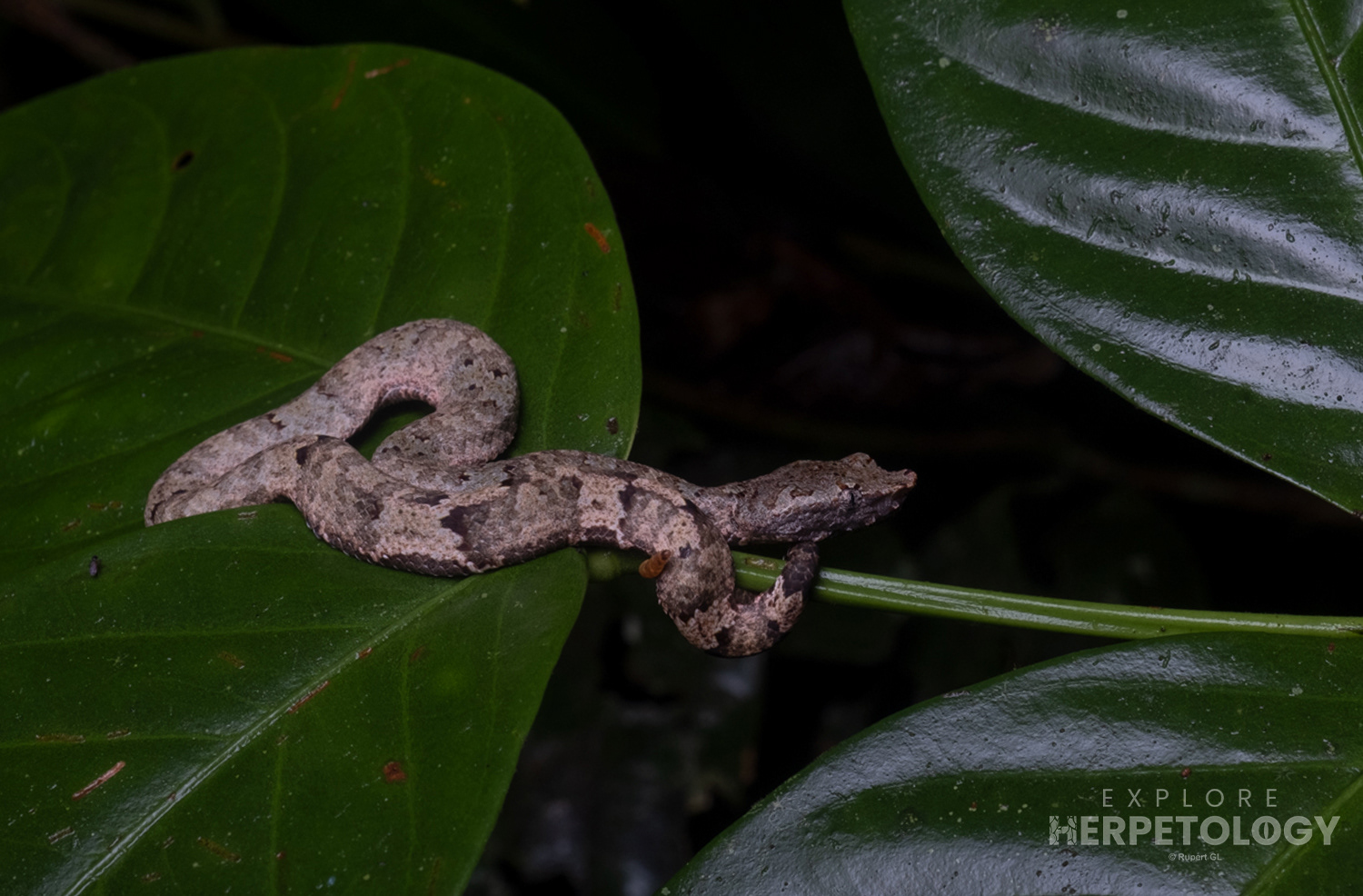
Juvenile female Wirot's pit viper (Craspedocephalus wiroti).
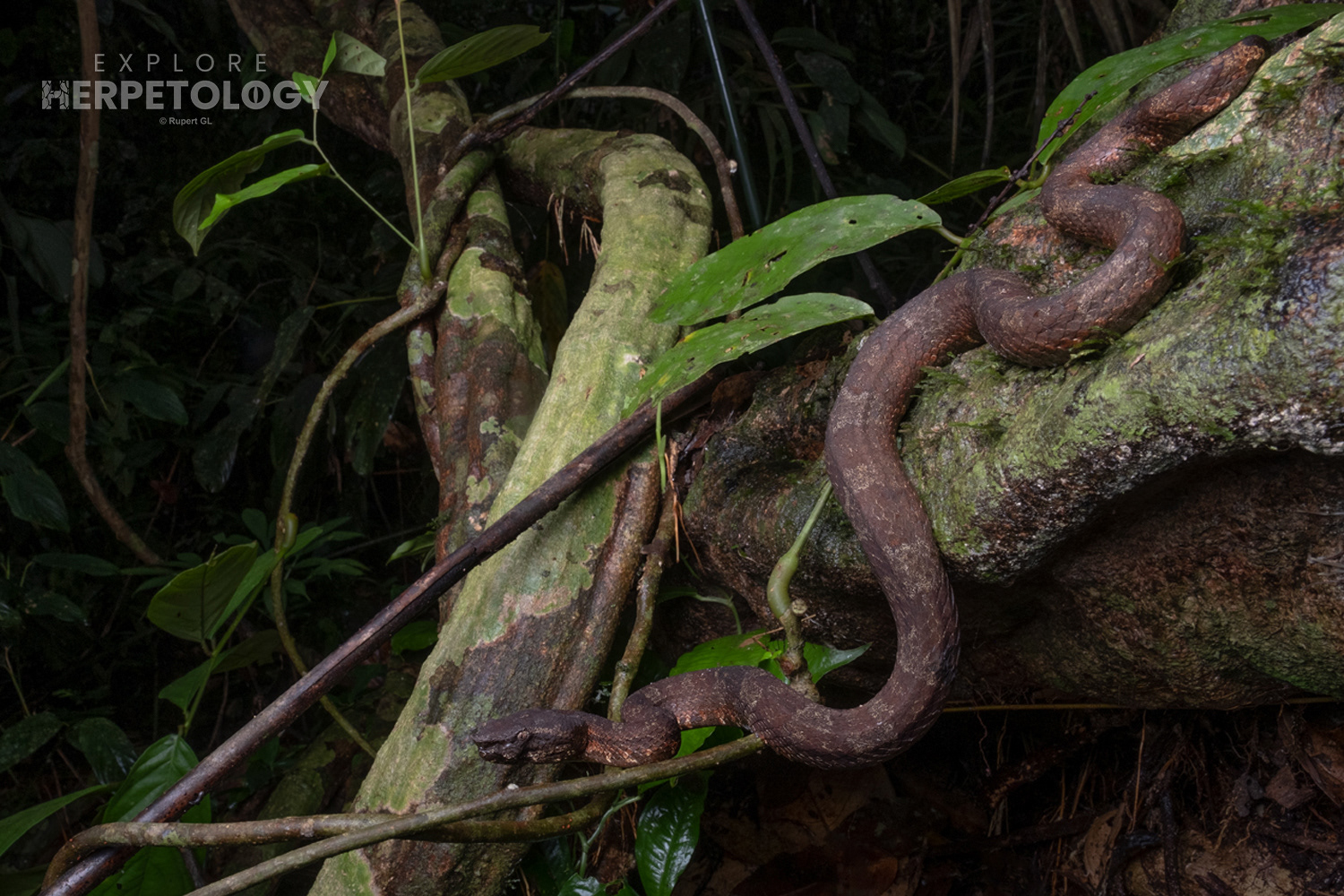
Adult female Wirot's pit viper (Craspedocephalus wiroti).
Amongst the Wirot’s observations were more T. hageni and Ahaetulla mycterizans sightings, as well as a beautiful little rusty-barred kukri snake (Oligodon signatus) and some cool lizards.
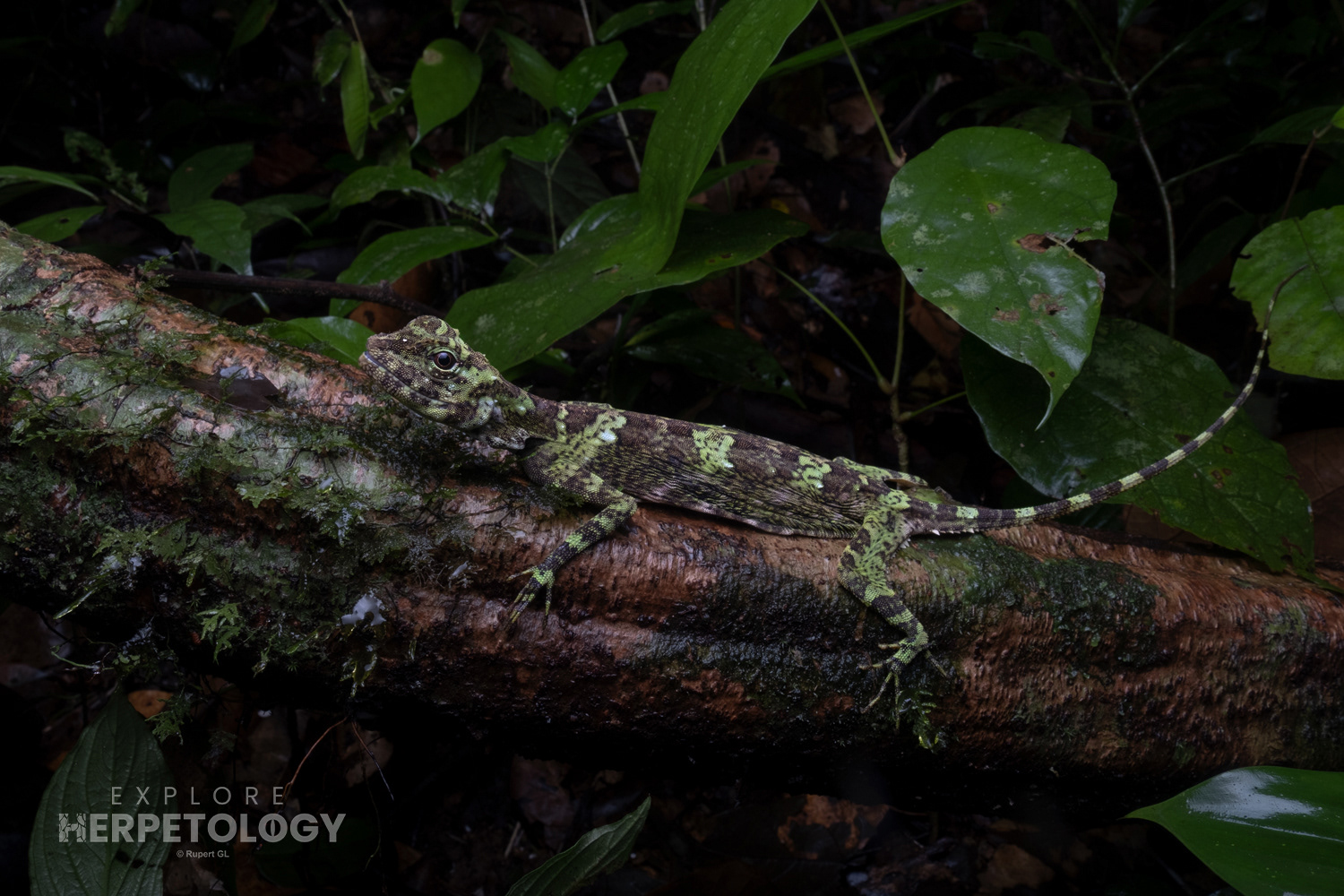
Giant flying lizard (Draco maximus)
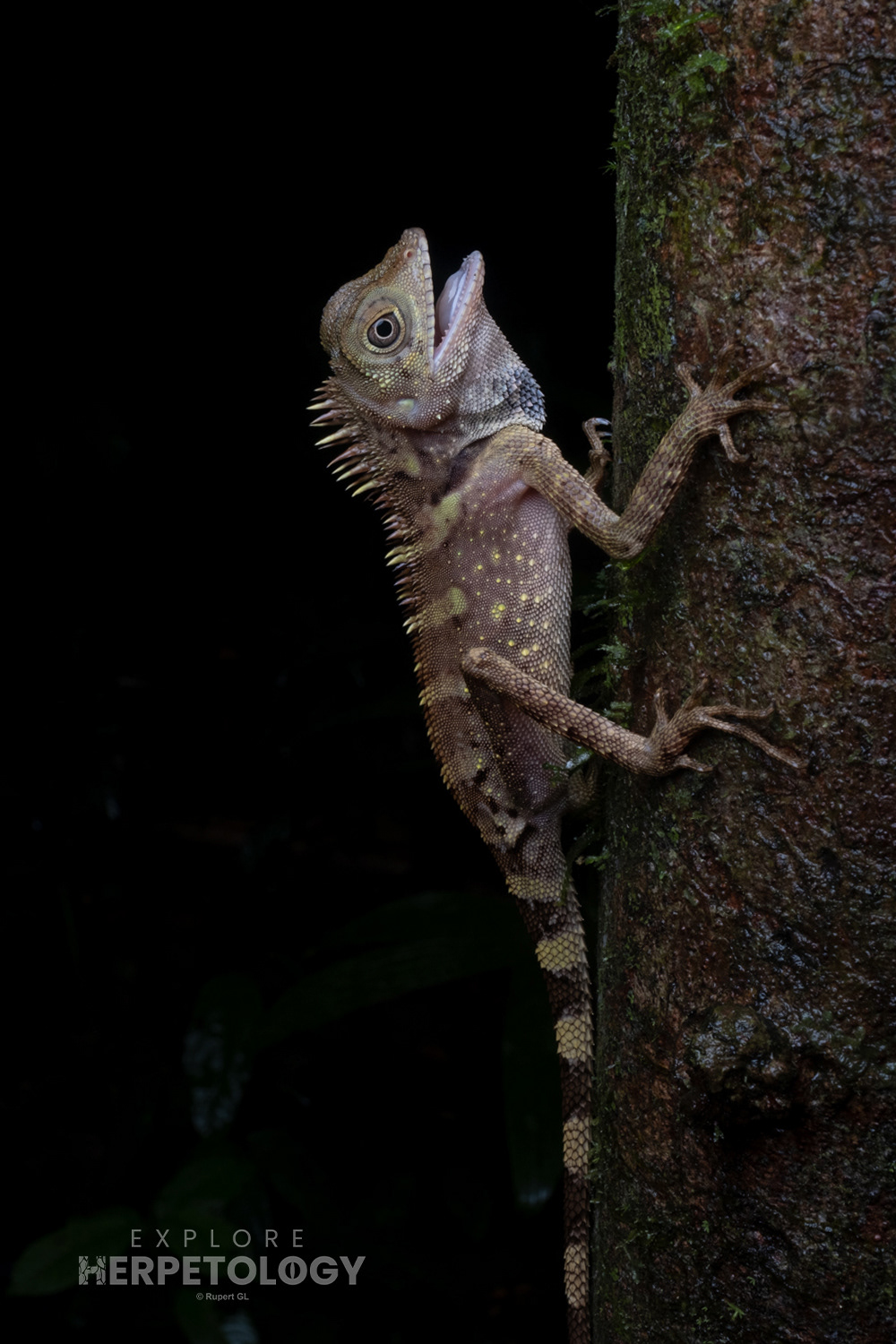
Bell's angle-headed lizard (Gonocephalus belli)
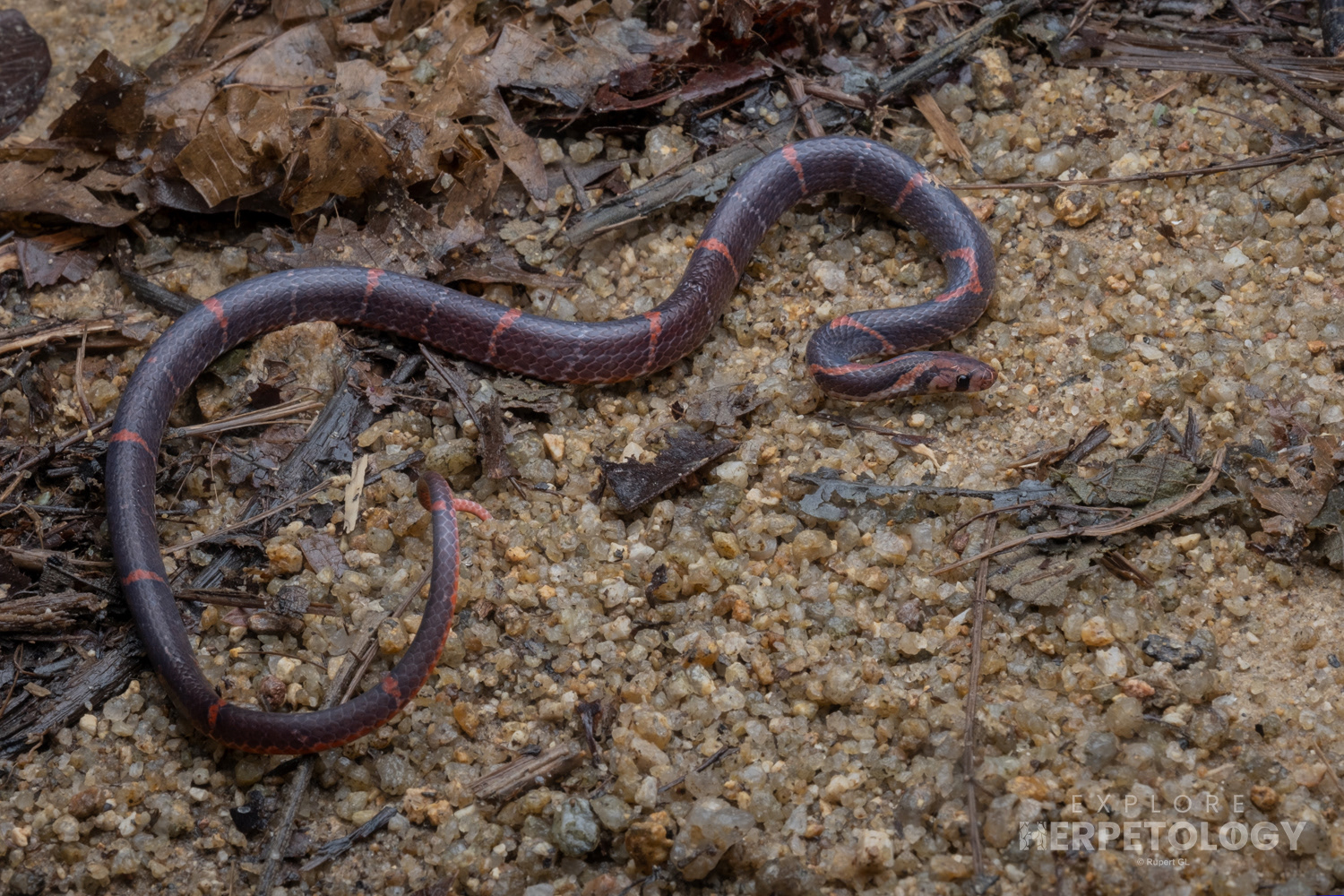
Rusty-barred kukri snake (Oligodon signatus)
The next day, we embarked on our first morning walk of the expedition and Jen spotted a dark-headed cat snake (Boiga nigriceps) coiled up resting in the rafters of a building close to our accommodation. We also found a cute wide-disked bullfrog (Kaloula latidisca) and a water monitor (Varanus salvator) which was trapped in a well.
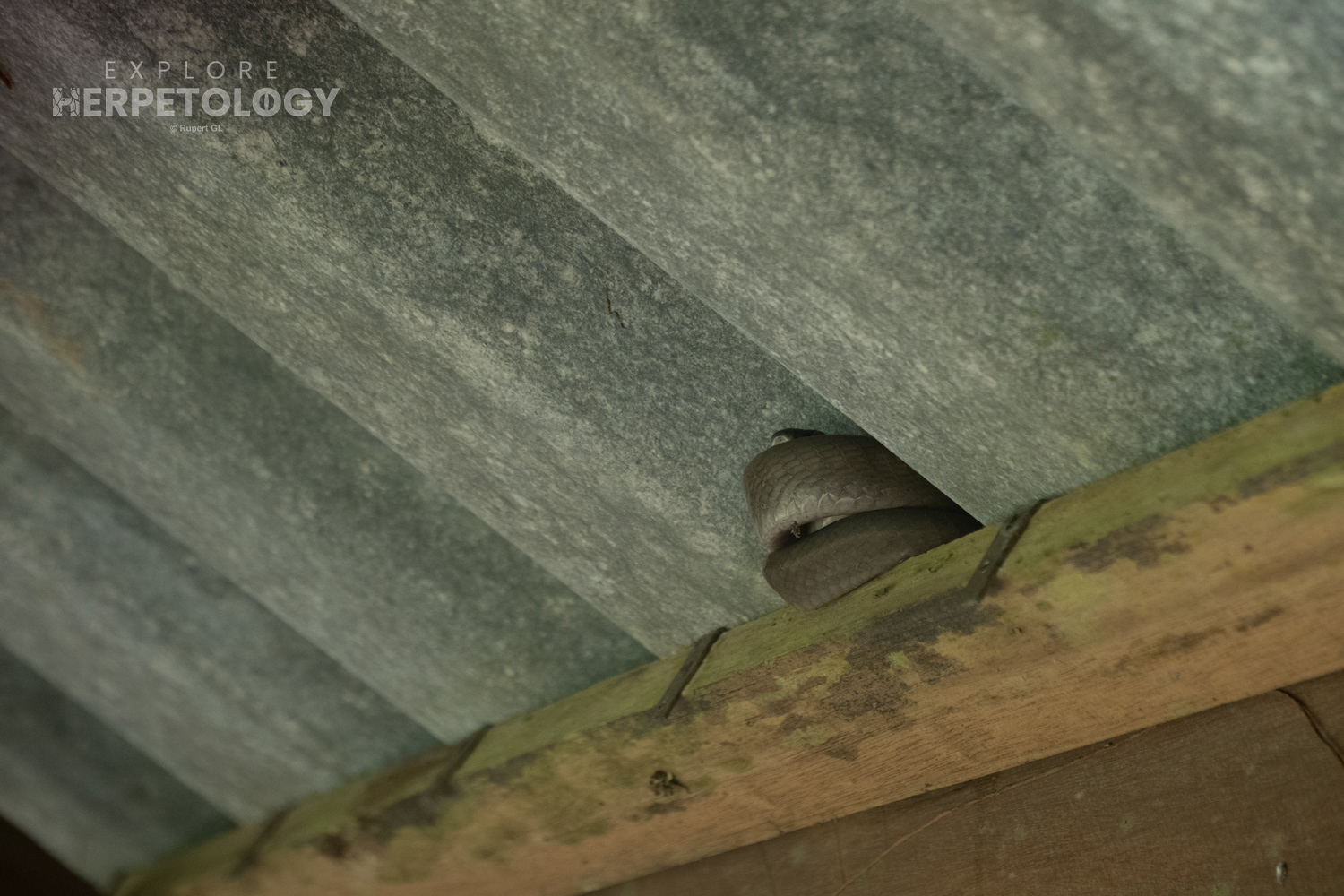
Dark-headed cat snake (Boiga nigriceps)
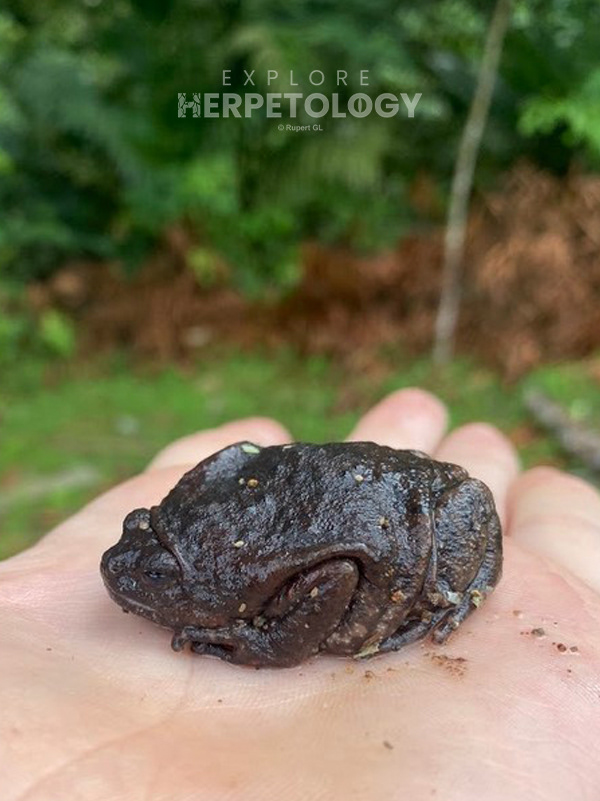
Wide-disked bullfrog (Kaloula latidisca)
Come nightfall, the first find was a black marsh turtle (Siebenrockiella crassicolis) crossing the road. Next, we split into two groups. One group further explored the river from the night before, while I brought a group of 3 to a new site which is typically very difficult to herp, but can turn up some special snakes. My group’s very first find was a huge and stunning striped coral snake (Calliophis intestinalis), followed by a triangle keelback (Xenochrophis trianguligerus), a very cool sub-adult brown wolf snake (Lycodon effraenis), and lastly the trip's first adult male Hagen’s pit-viper (Trimeresurus hageni).
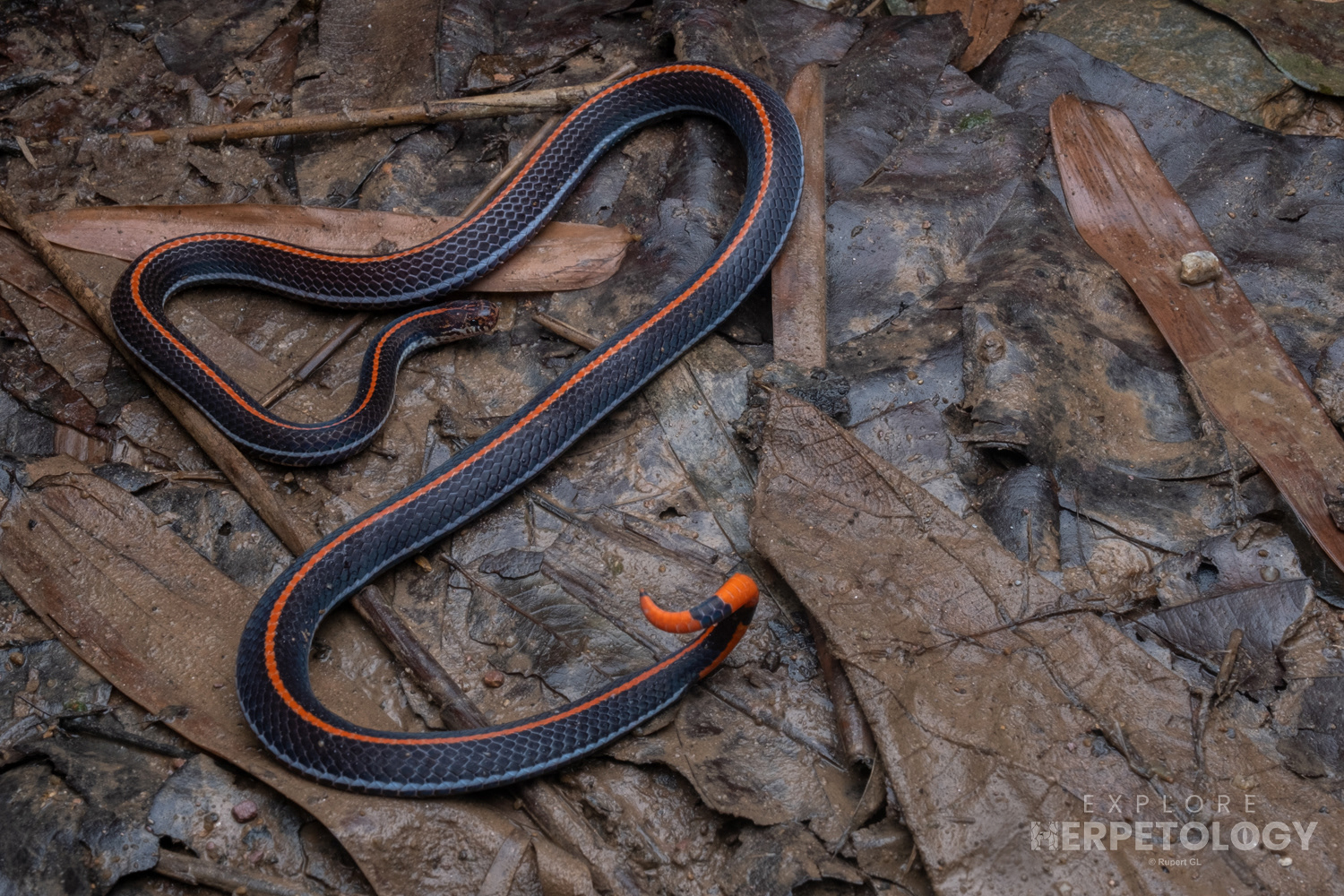
Striped coral snake (Calliophis bivirgata)
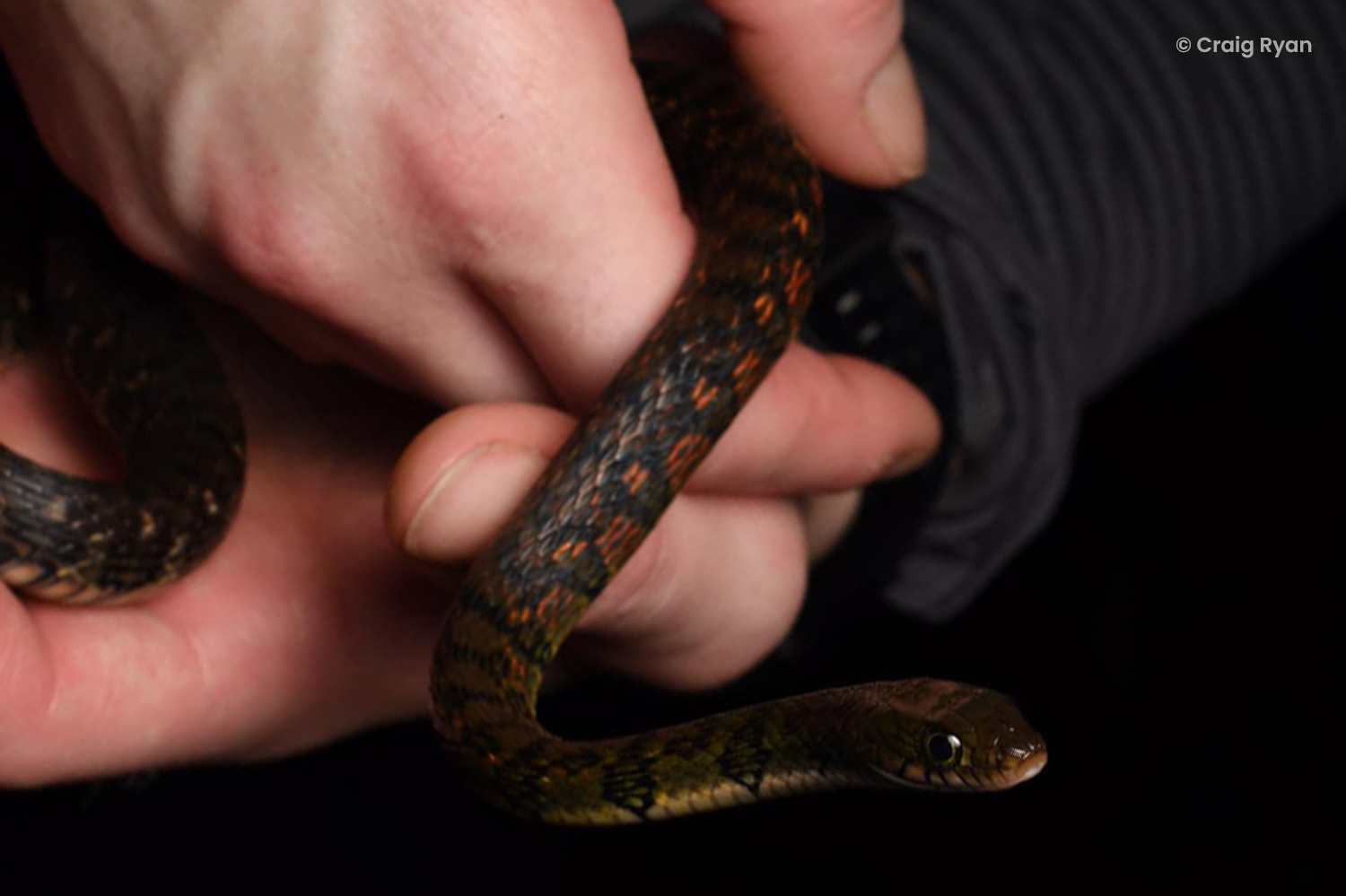
Triangle keelback (Xenochrophis trianguligerus).
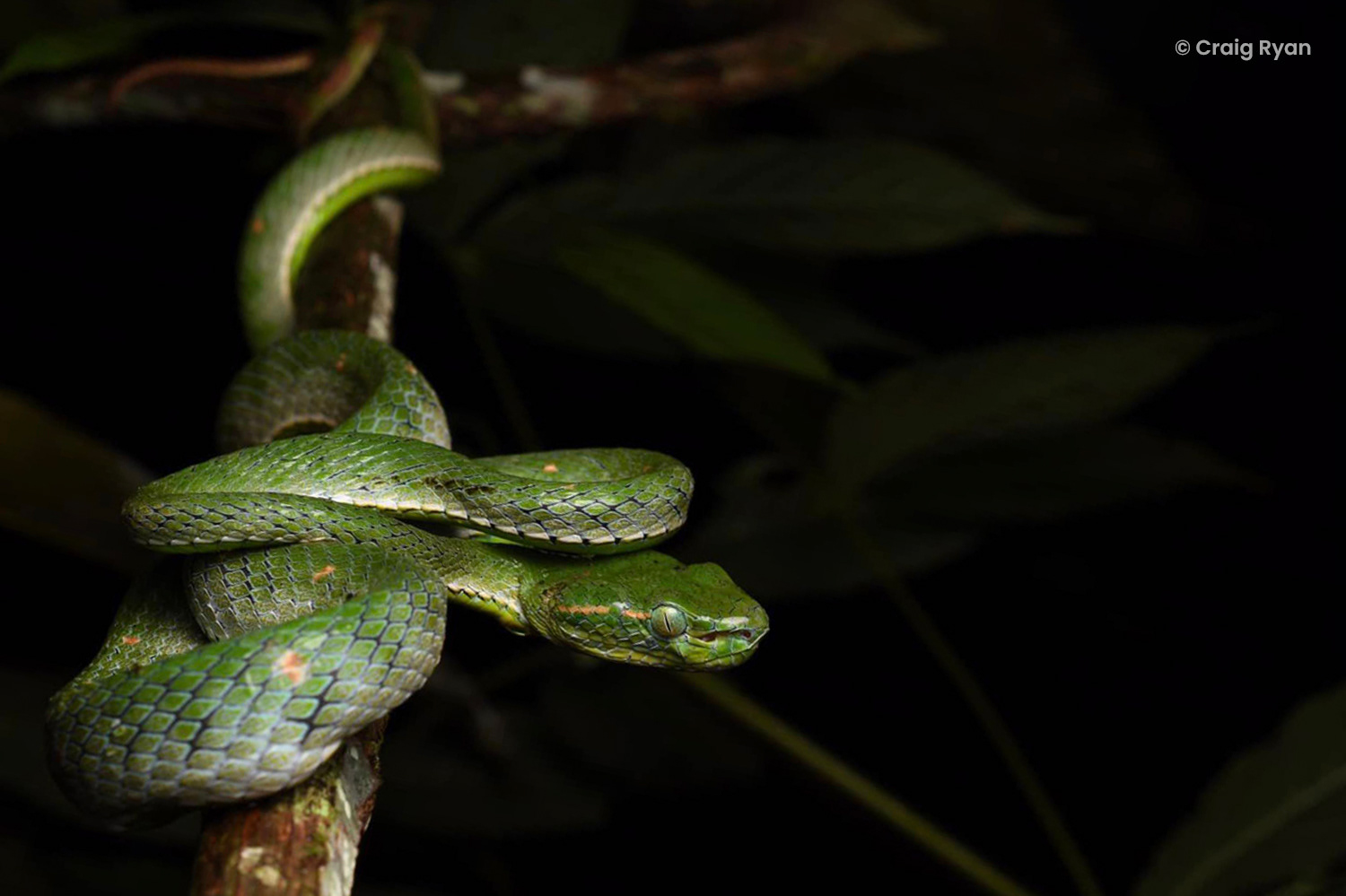
Hagen's pit viper (Trimeresurus hageni).
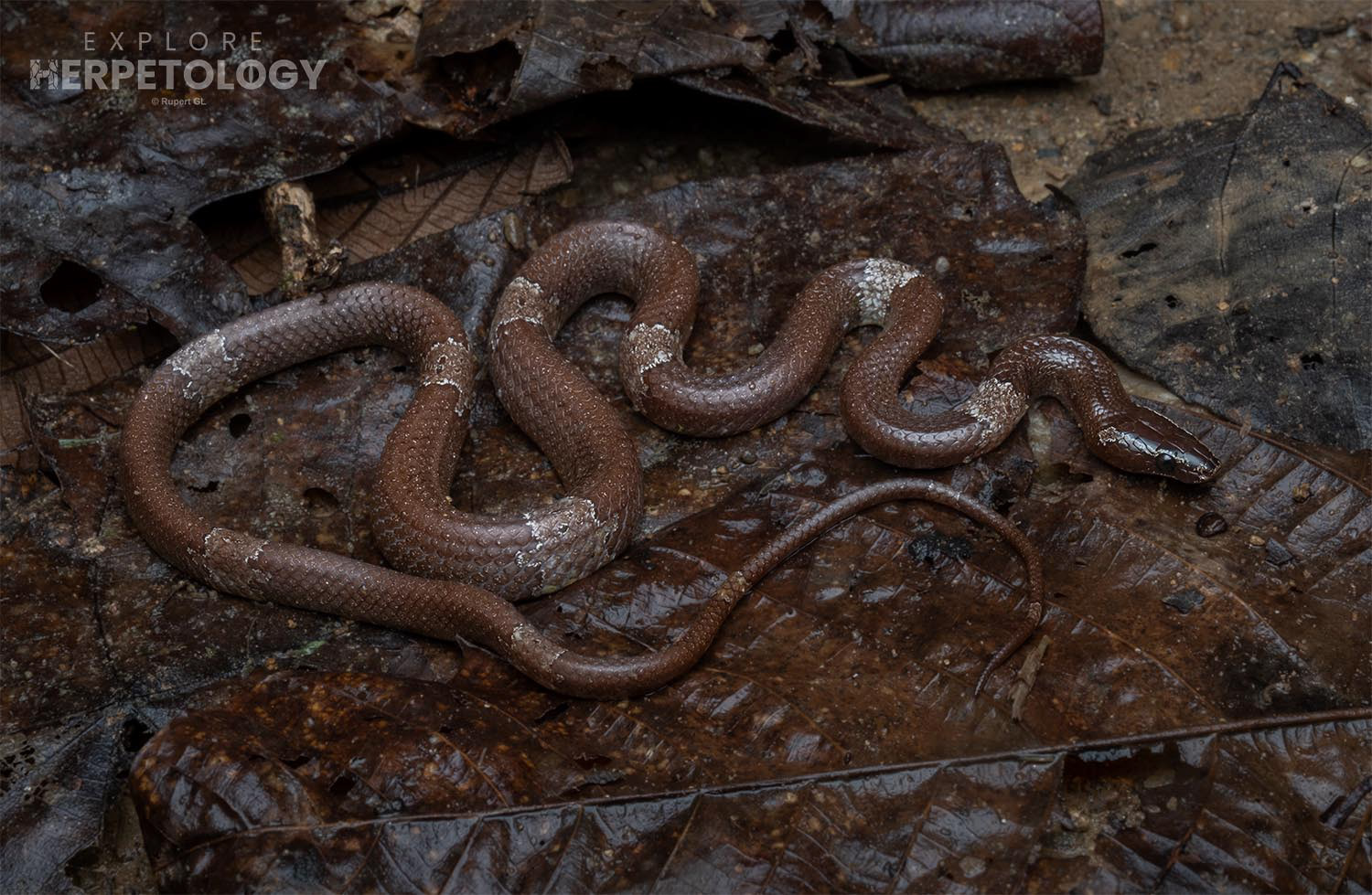
Brown wolf snake (Lycodon effraenis).
Harry and David’s group found several species too, most notably our first dusky wolf snake (Lycodon albofuscus) and sunbeam snake (Xenopeltis unicolor) of the trip, as well as an adult Malayan banded wolf snake (Lycodon subcinctus) and a very cool Malaccan slug snake (Asthenodipsas malaccanus).
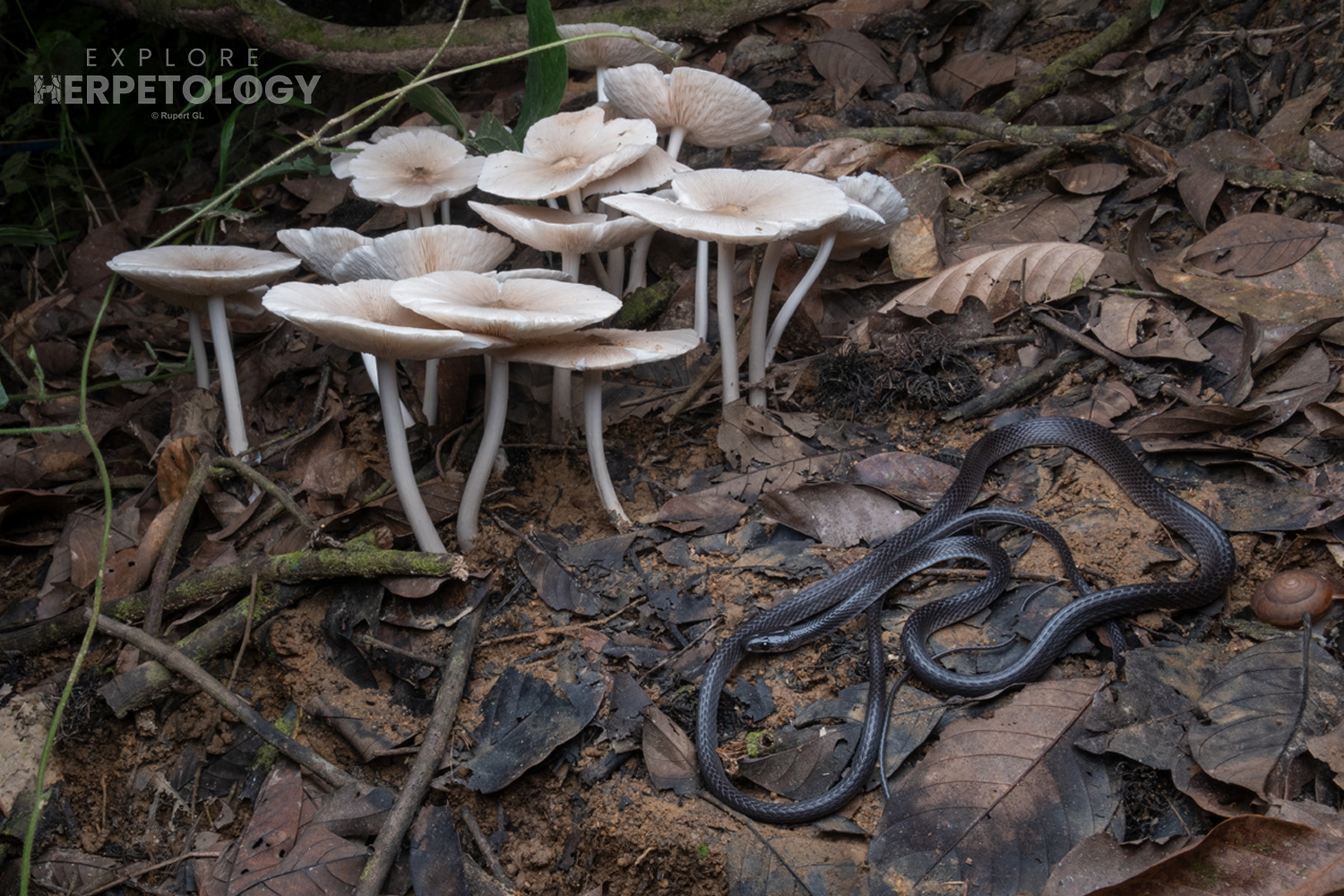
Dusky wolf snake (Lycodon albofuscus).
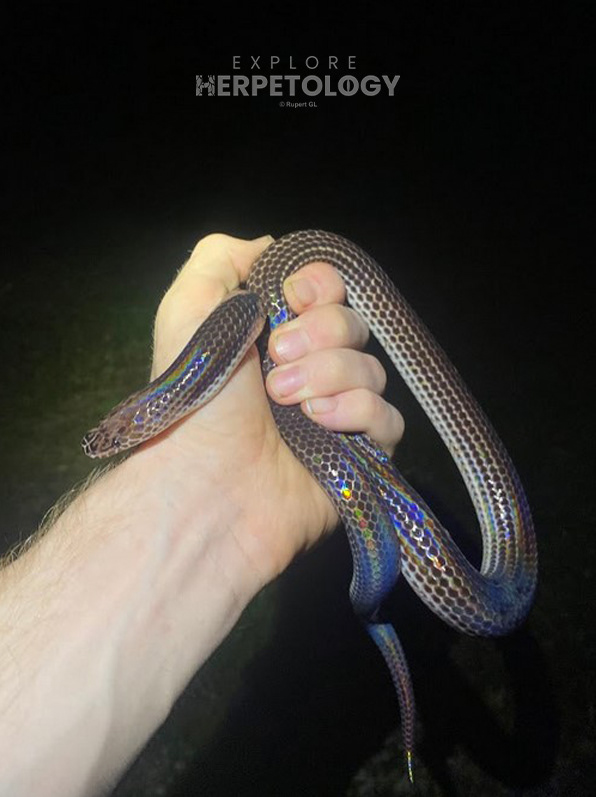
Sunbeam snake (Xenopeltis unicolor).

Malayan wolf snake (Lycodon subcinctus).

Malaccan slug snake (Asthenodipasa mallaccanus).
Day 4 of the trip began with another daytime walk and we once again bore witness to the luscious beauty of Narathiwat’s primary dipterocarp rainforest. The only snake seen was a hatchling Hagen’s pit-viper (Trimeresurus hageni) which was photographed in-situ.
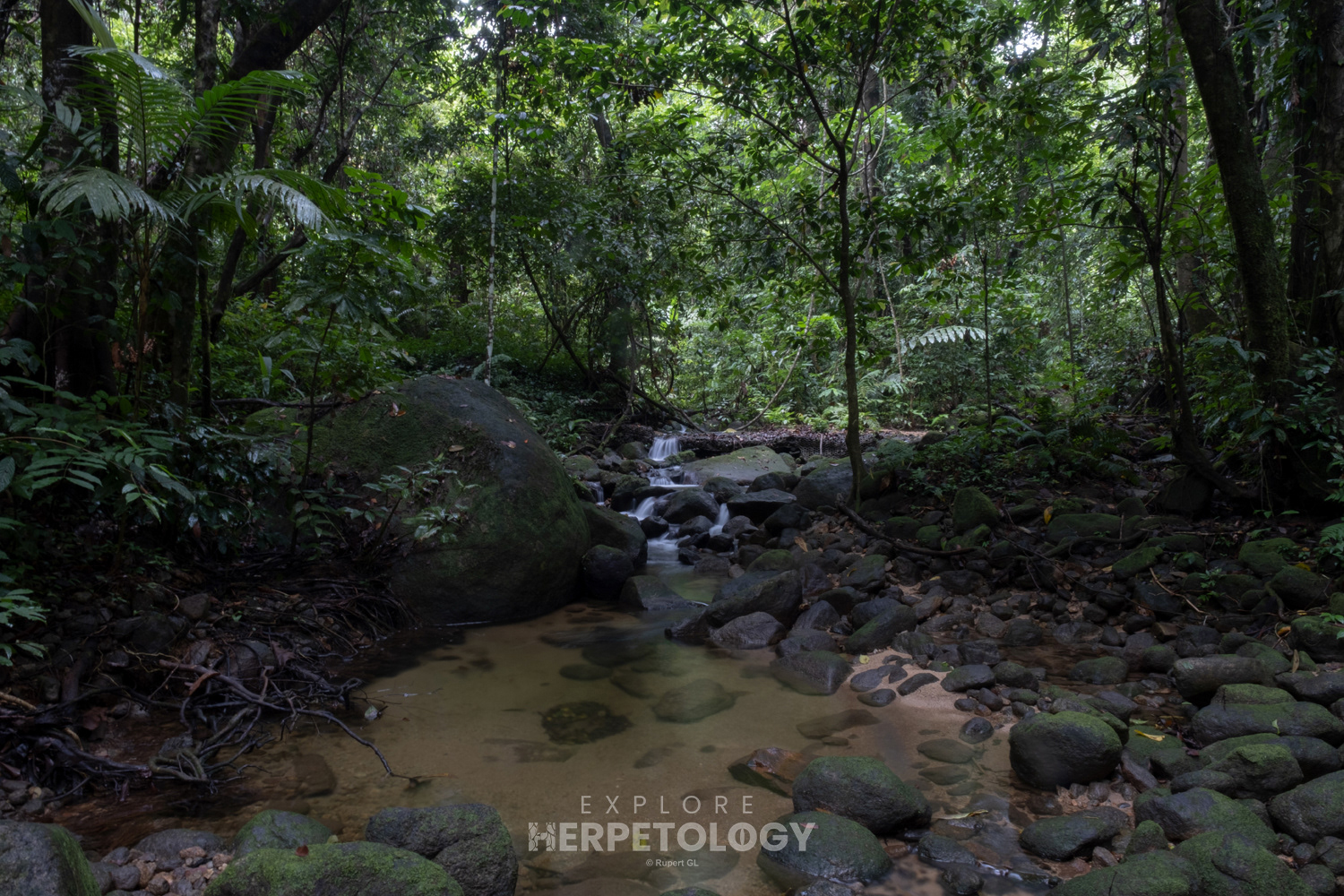
Stream habit during the day.

Juvenile Hagen's pit viper (Trimeresurus hageni)
That evening, I spent some time in the swamps while the rest of the group did a shorter walk near our accommodation. I found a pipe snake (Cylindrophis cf. jodiae), a few dusky wolf snakes (Lycodon albofuscus), another adult Hagen’s pit-viper (Trimeresurus hageni), and a juvenile puff-faced water snake (Homalopsis buccata). The best find of my walk was 2 dwarf reed snakes (Pseudorabdion longiceps), the first I’d ever seen in Thailand.
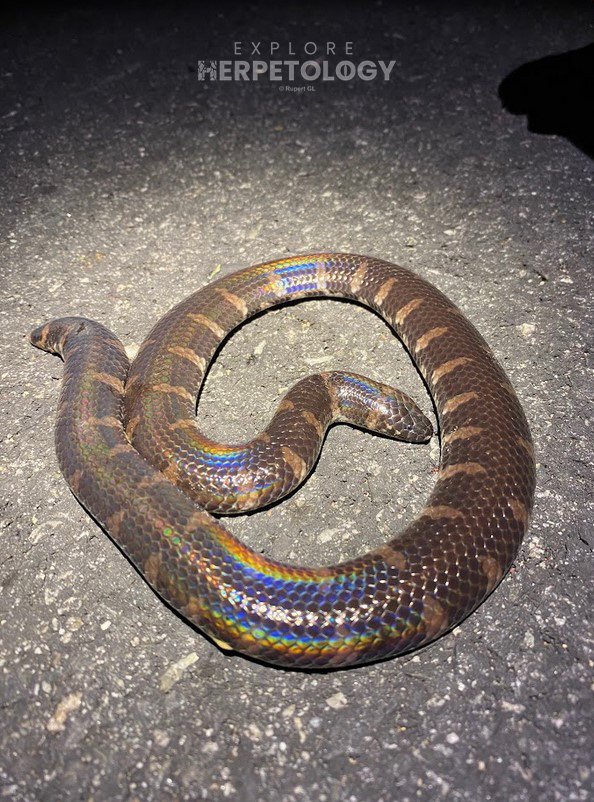
Jodi's pipe snake (Cylindrophis jodiae).
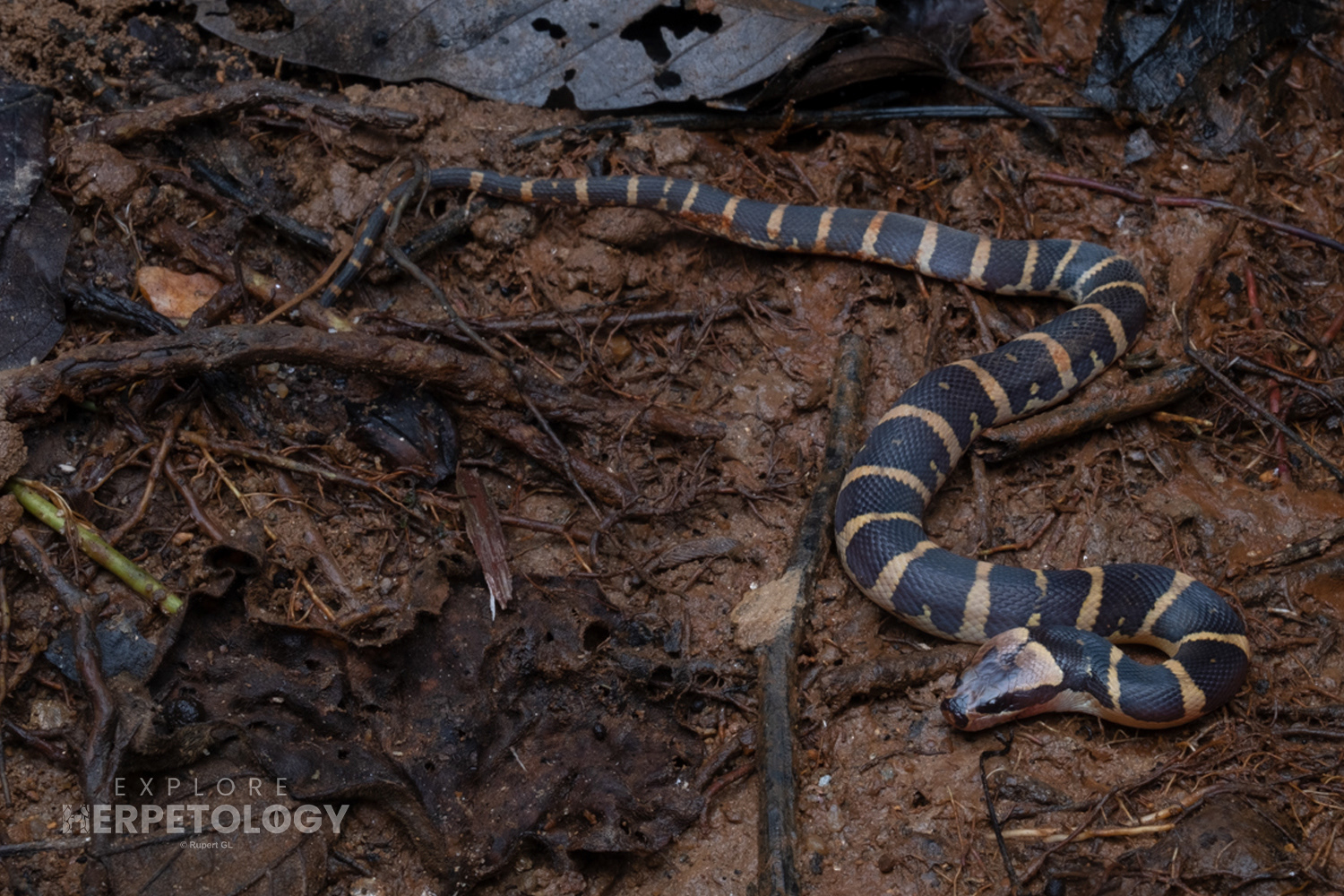
Puff-faced water snake (Homalopsis buccata)
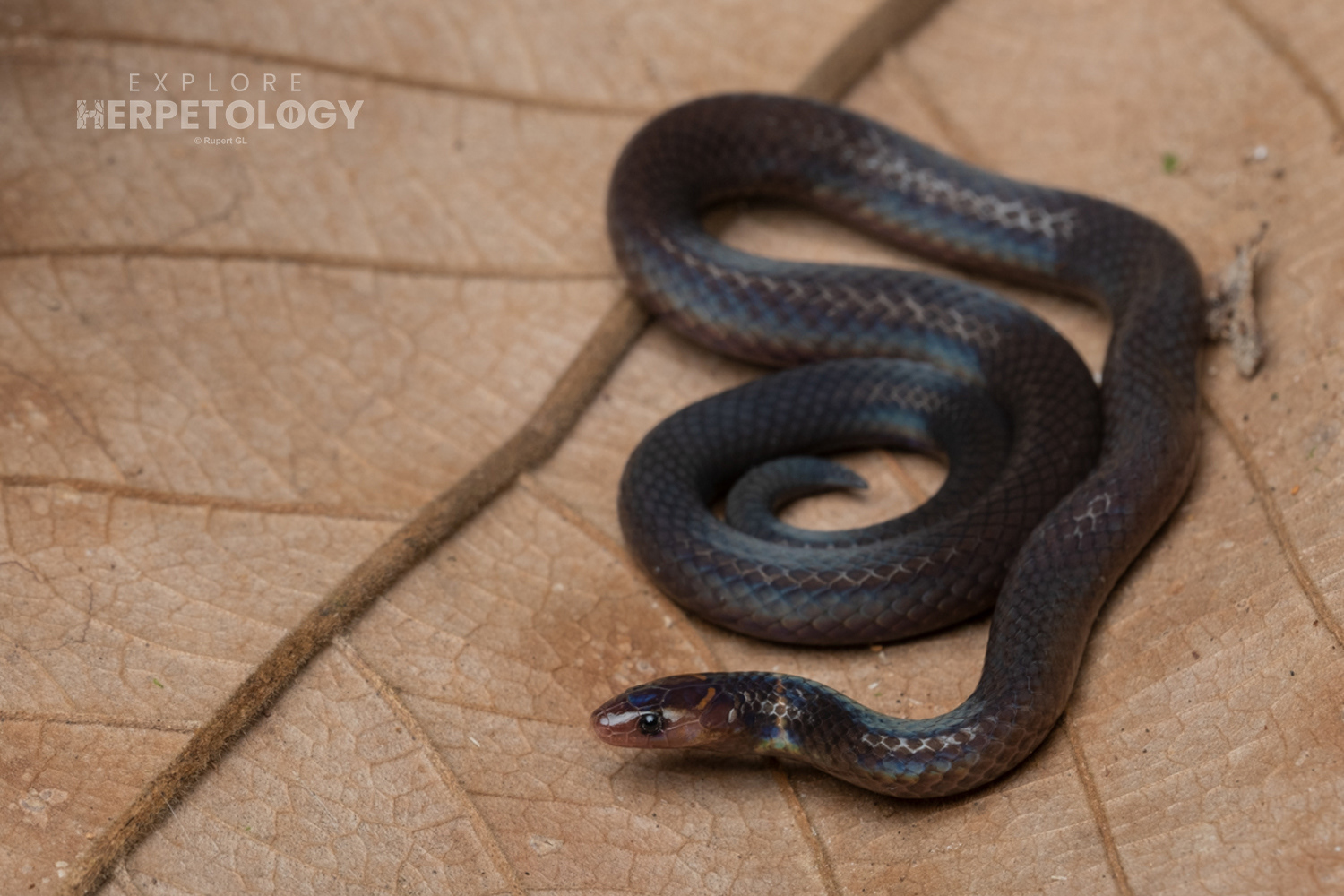
Dwarf reed snake (Pseudorabdion longiceps)
Meanwhile, the rest of the group found a few common species we’d seen the previous nights, along with an adult male Sumatran pit-viper (Trimeresurus sumatranus), completing the holy trinity of Narathiwat’s iconic must-see snakes (blue coral, Wirot’s, and sumatranus). They also found the area’s most iconic frog, the long-nosed horned frog (Pelobatrachus nasuta).
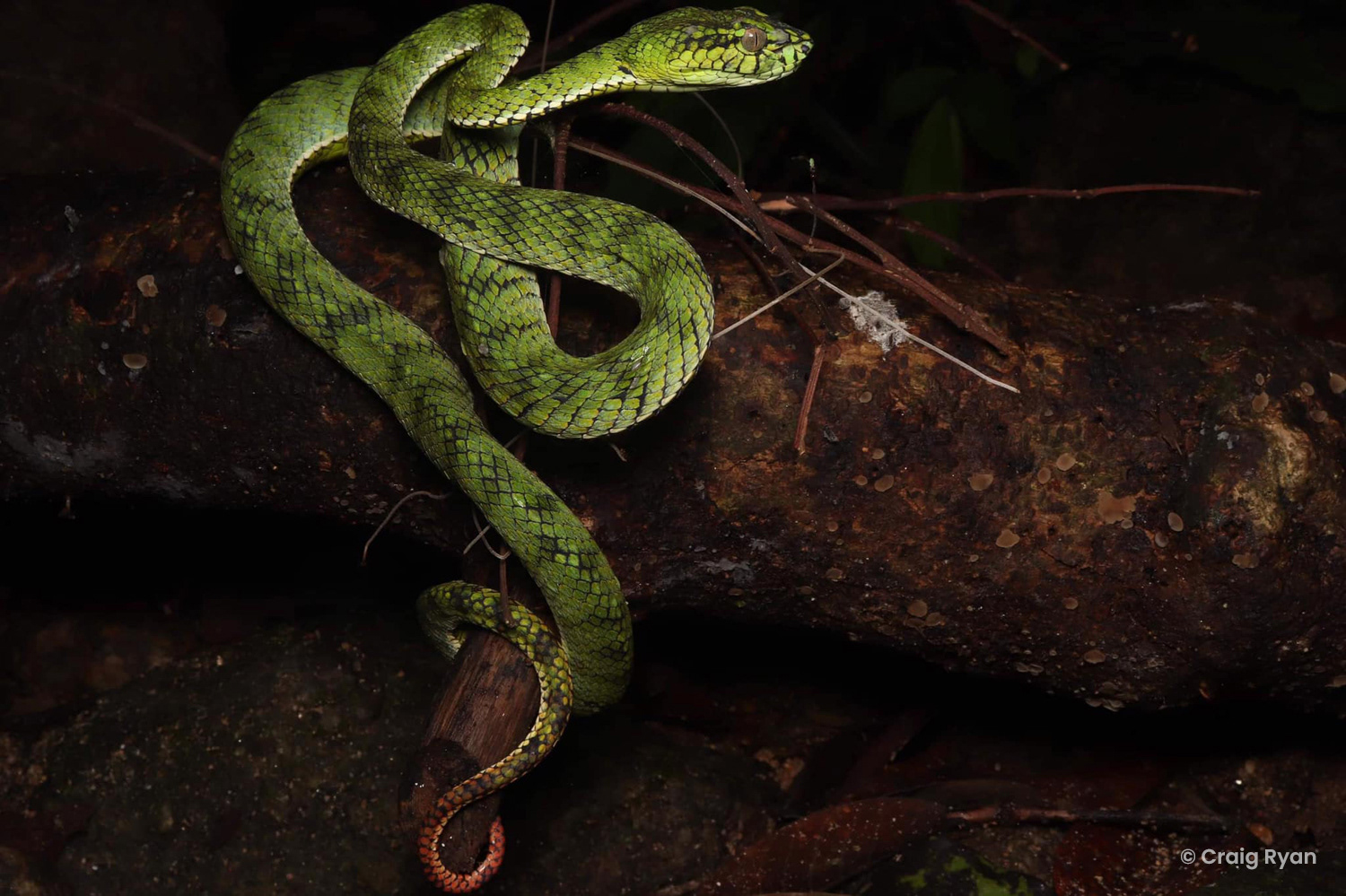
Sumatran pit viper (Trimeresurus sumatranus)
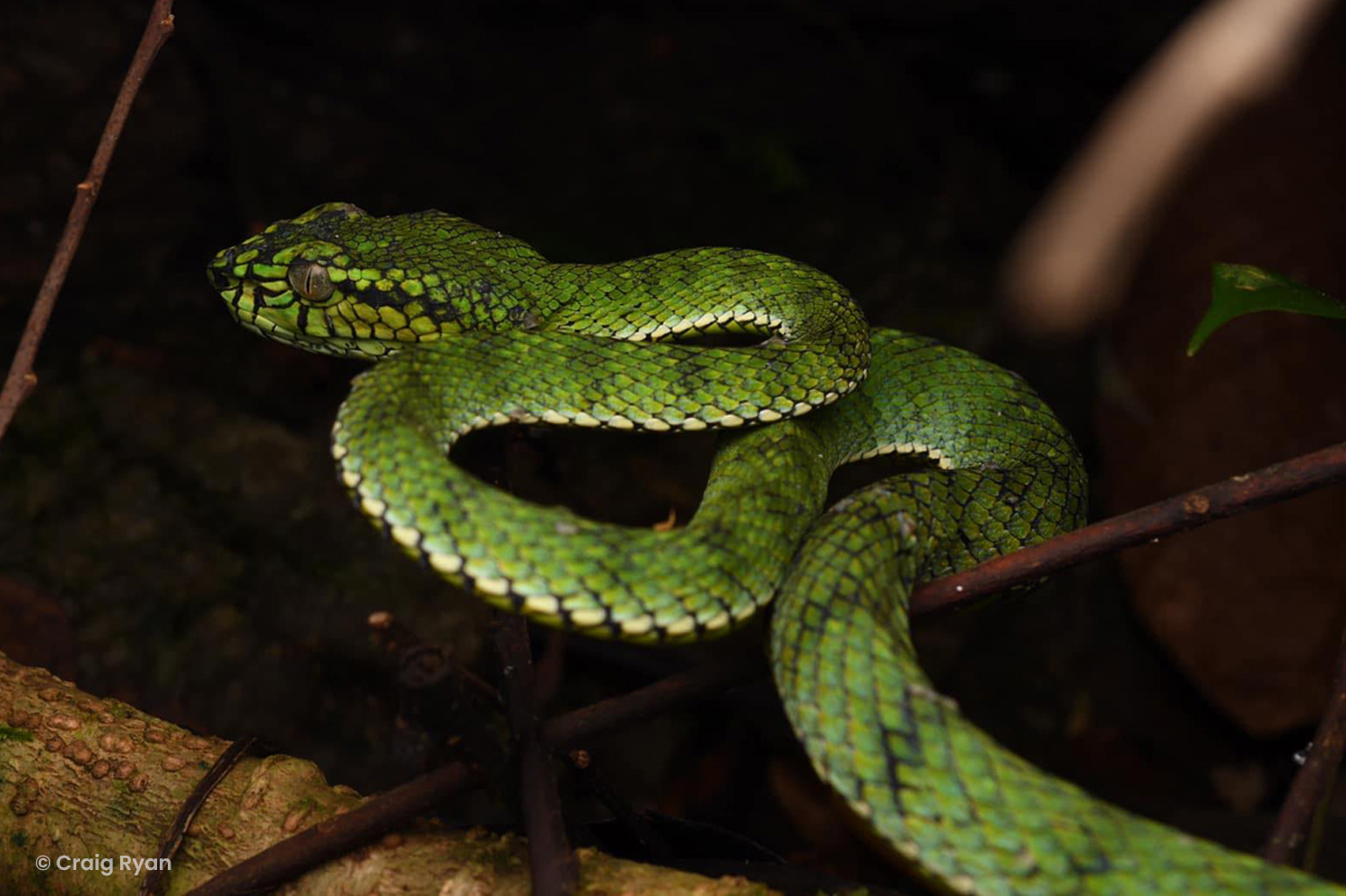
Sumatran pit viper (Trimeresurus sumatranus)
Tiredness from an intense first 4 nights was already creeping up on our group, so we took the daytime off on day 5 and decided on a short night walk at an easier location. The first find was one our guests had been greatly looking forward to, an adult mangrove cat snake (Boiga melanota). Next, David found a juvenile of the Ex-Herp staff’s biggest target in the lowlands of Southern Thailand - the orange-lipped keelback (Rhabdophis flaviceps). Besides these, we only saw common (repeat) species on this walk, but the keelback was incredibly special.
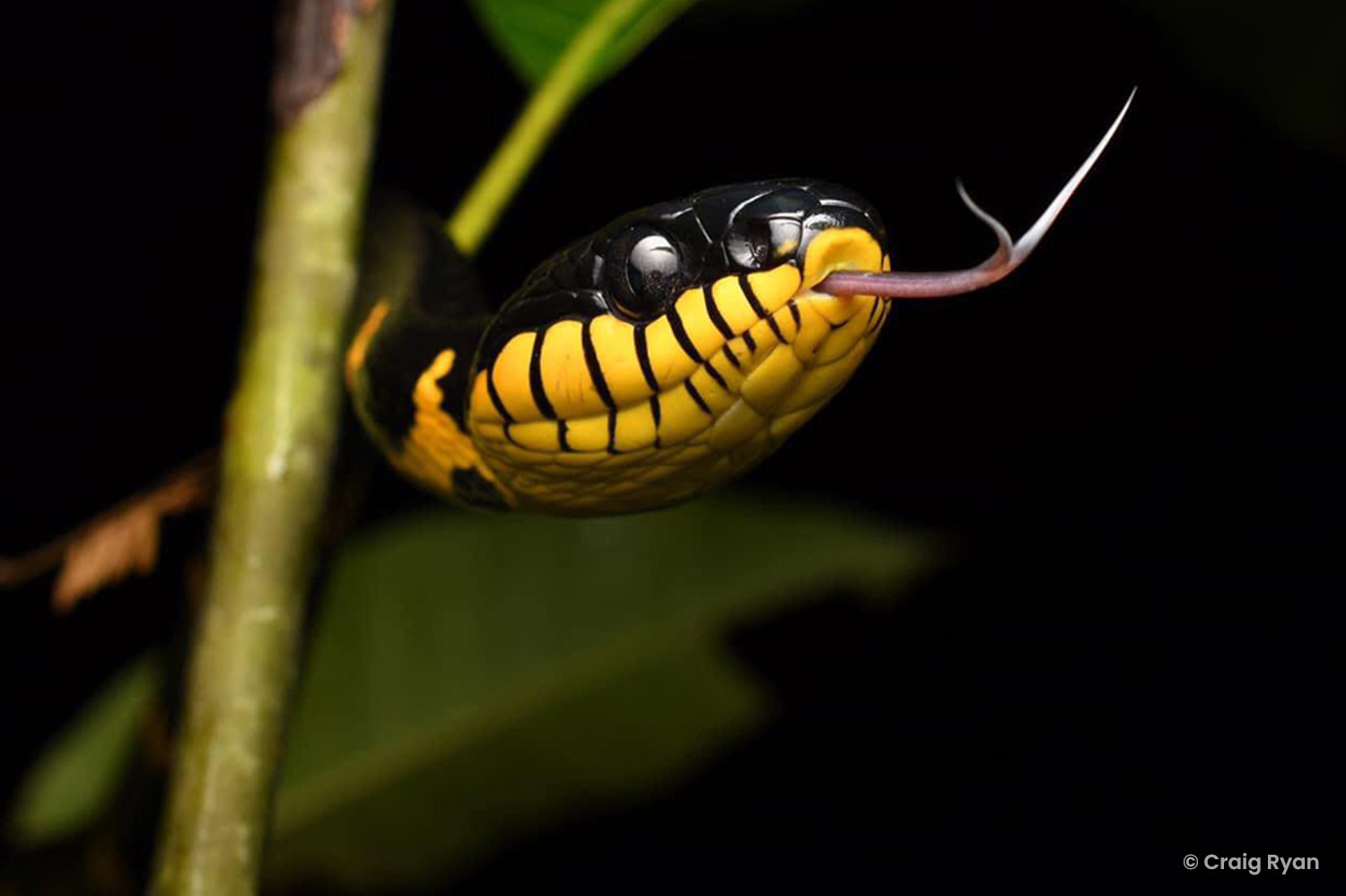
Mangrove snake (Boiga melanota).

Juvenile Orange-lipped keelback (Rhabdophis flaviceps)
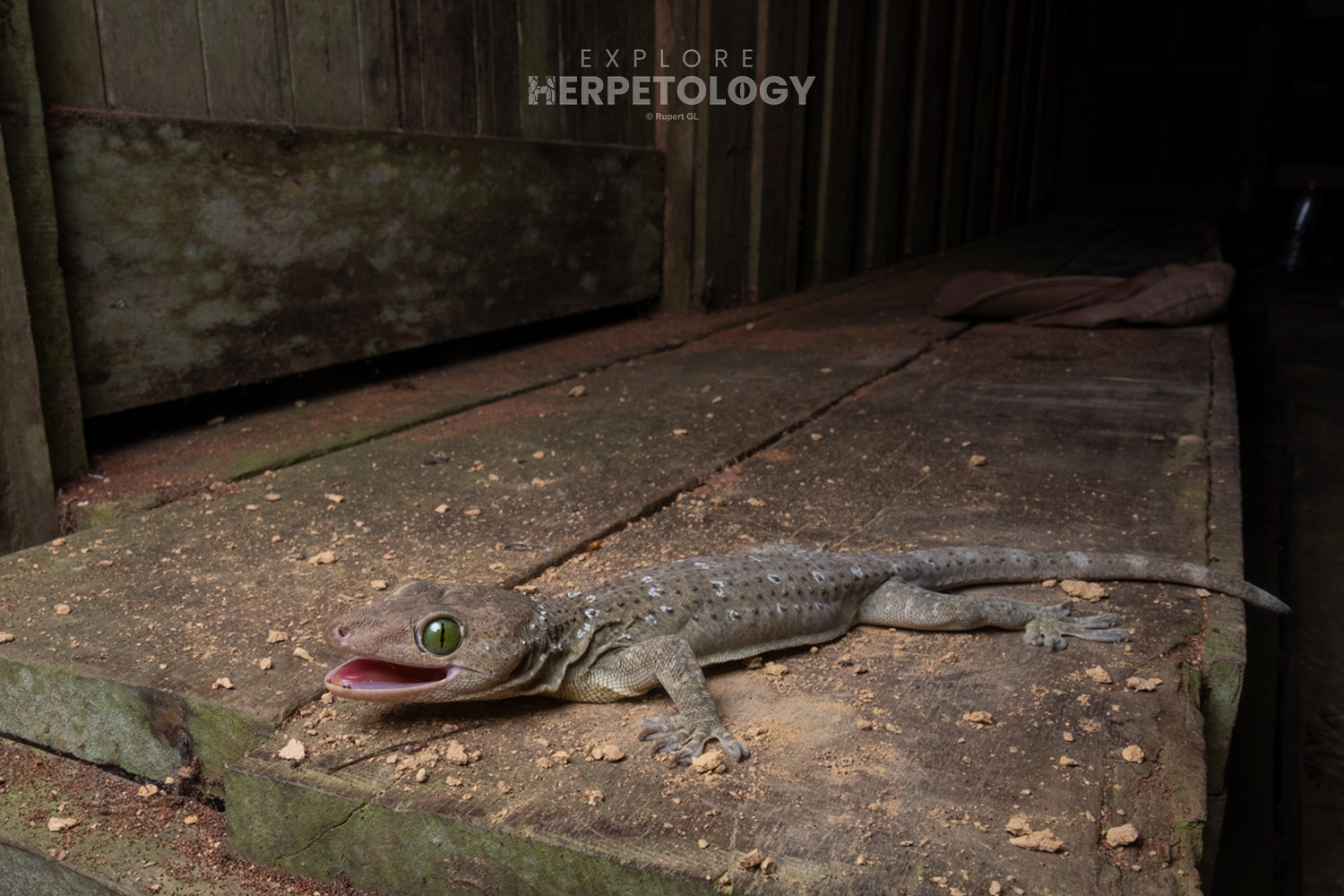
Giant green-eyed gecko (Gekko hulk)
For the final night in Narathiwat, we had another great evening with several major highlights. We found 2 new bronzeback species for the trip, starting with a juvenile striped bronzeback (Dendrelaphis caudolineatus) which was followed by a large Haas’ bronzeback (Dendrelaphis haasi). We also encountered the first and only oriental vine snake (Ahaetulla prasina) of the trip.

Juvenile striped bronzeback (Dendrelaphis caudolineatus)
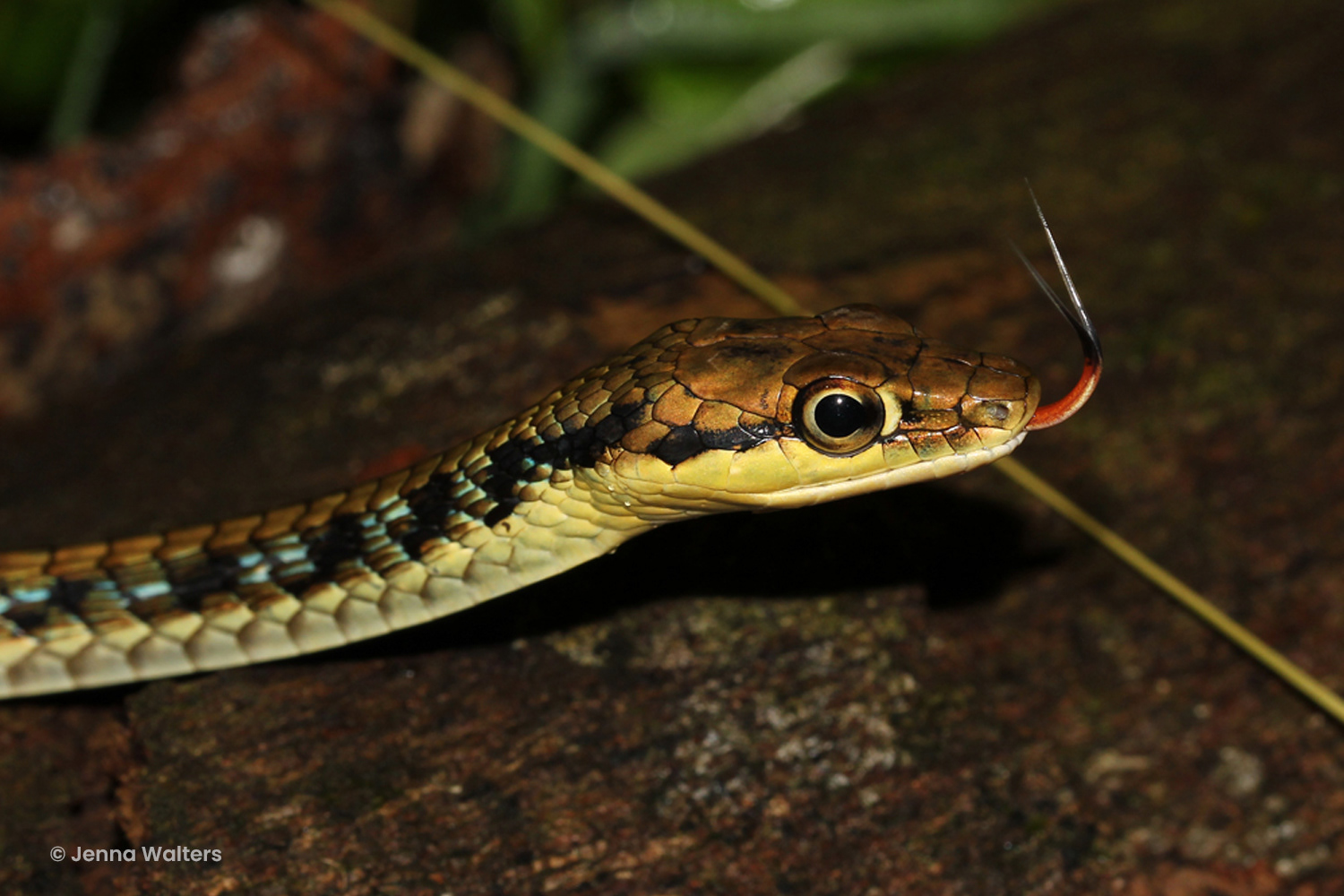
Haas' bronzeback (Dendrelaphis haasi)
Repeat species included a huge Boiga melanota, Boiga bengkuluensis and Boiga nigriceps, while we also found a new cat snake for the trip, a big dog-toothed cat snake (Boiga cynodon), and a yellow-striped racer (Coelognathus flavolineatus).
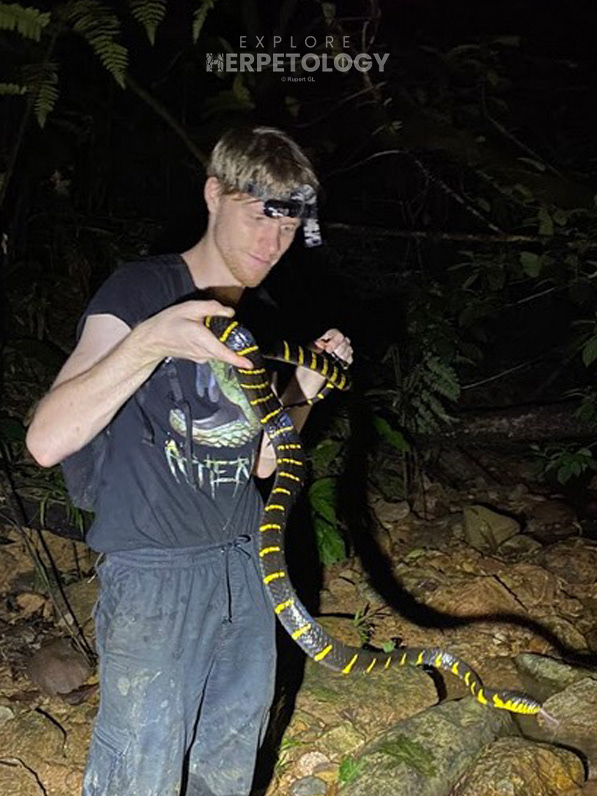
2m+ Mangrove cat snake (Boiga melanota)

Dog-toothed cat snake (Boiga cynodon)
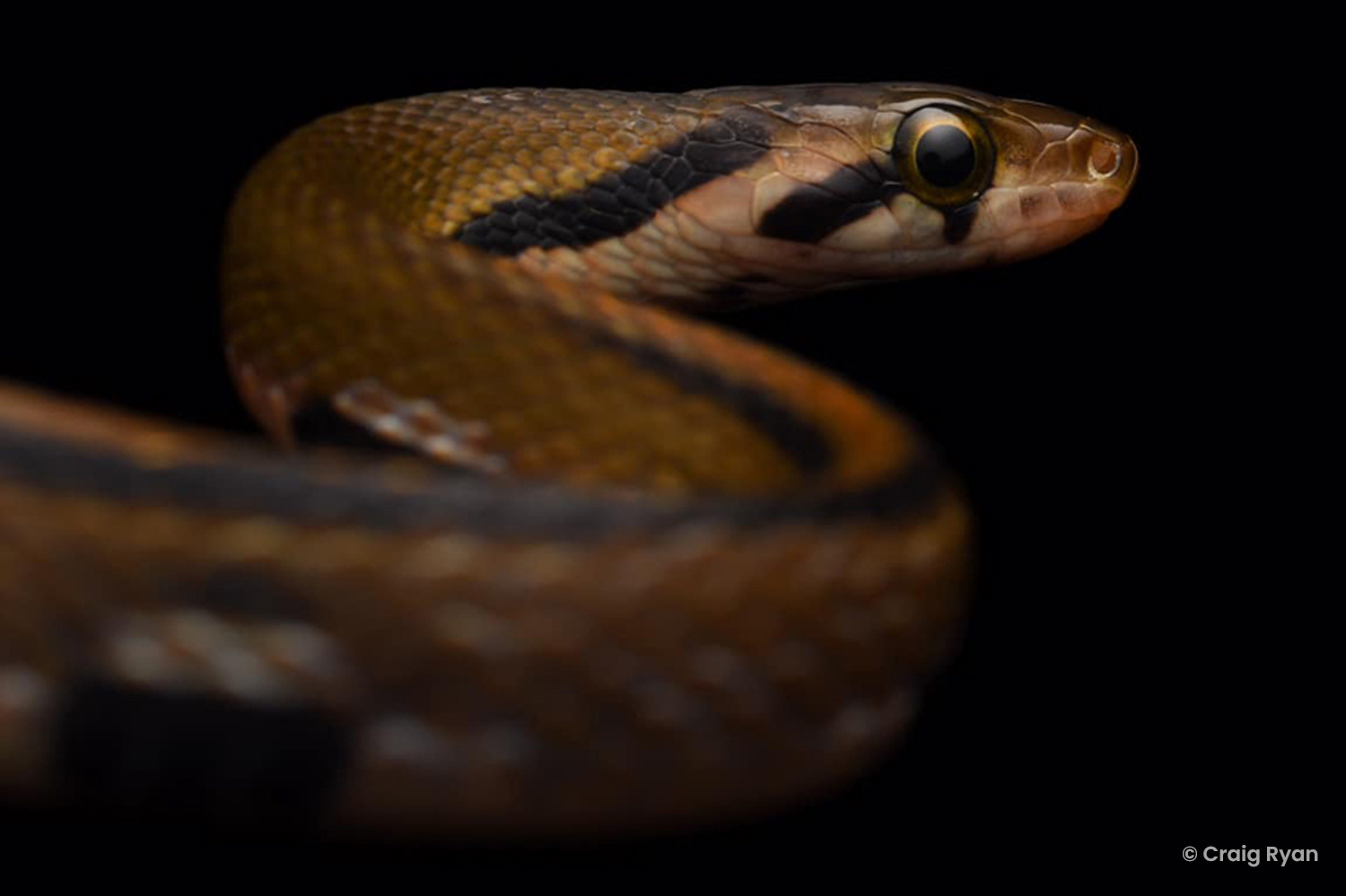
Malayan racer (Coelognathus flavolineatus).
While further exploring the swamps, David and I found another juvenile orange-lipped keelback (Rhabdophis flaviceps) and I then later caught my personal number 1 target of the trip, an enormous adult female orange-lipped keelback (Rhabdophis flaviceps) - possibly the first Thai individual caught by ‘western’ herpetologists.
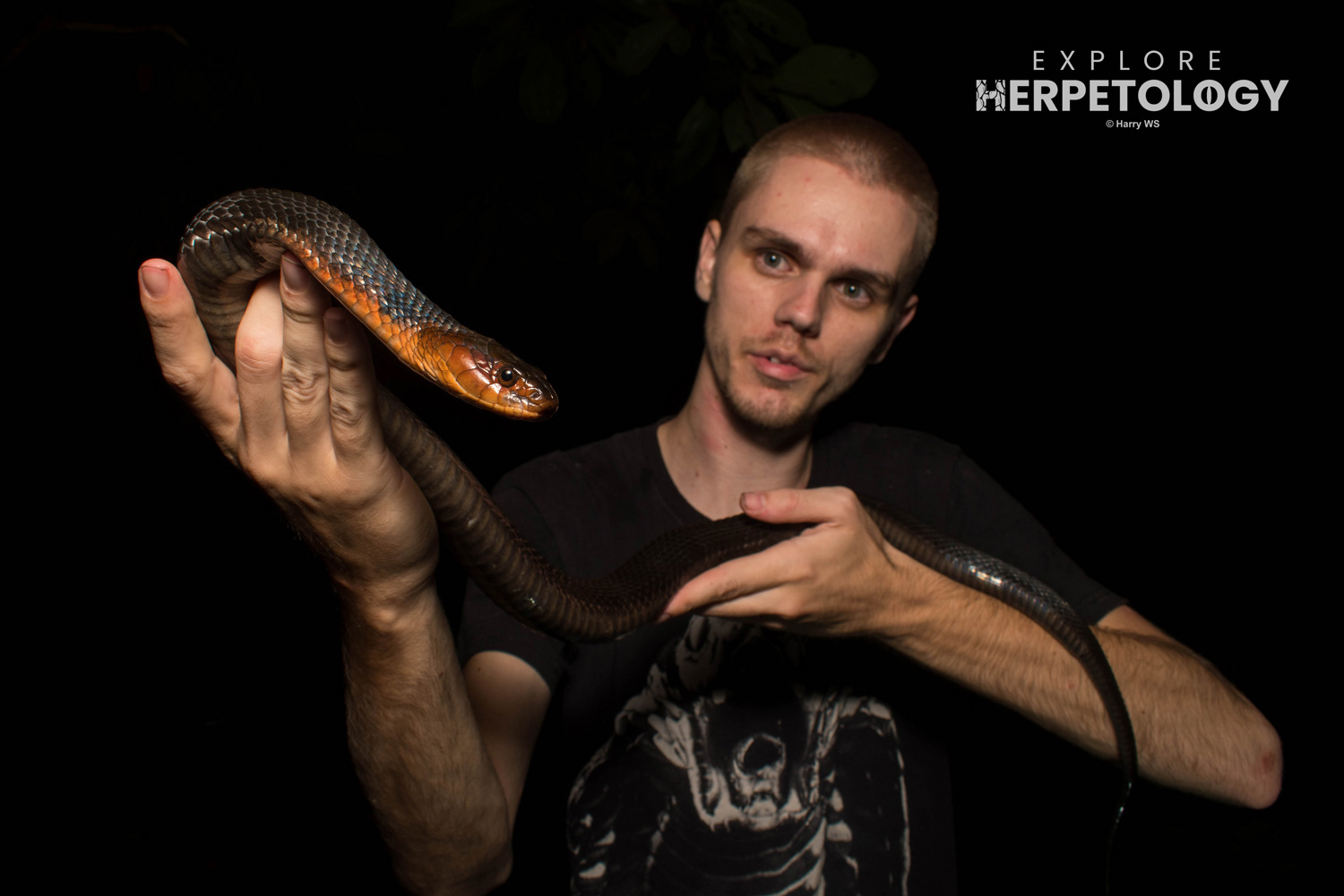
Adult Orange-lipped keelback (Rhabdophis flaviceps).

Adult Orange-lipped keelback (Rhabdophis flaviceps).
The final night fun did not stop there, however, as an incredible adult male Wirot’s pit-viper (Craspedocephalus wiroti) was found near our base camp. This spot by our guest Callum Grange certainly won him the award for “best guest find of the trip”.

Adult male Wirot's pit viper (Craspedocephalus wiroti).
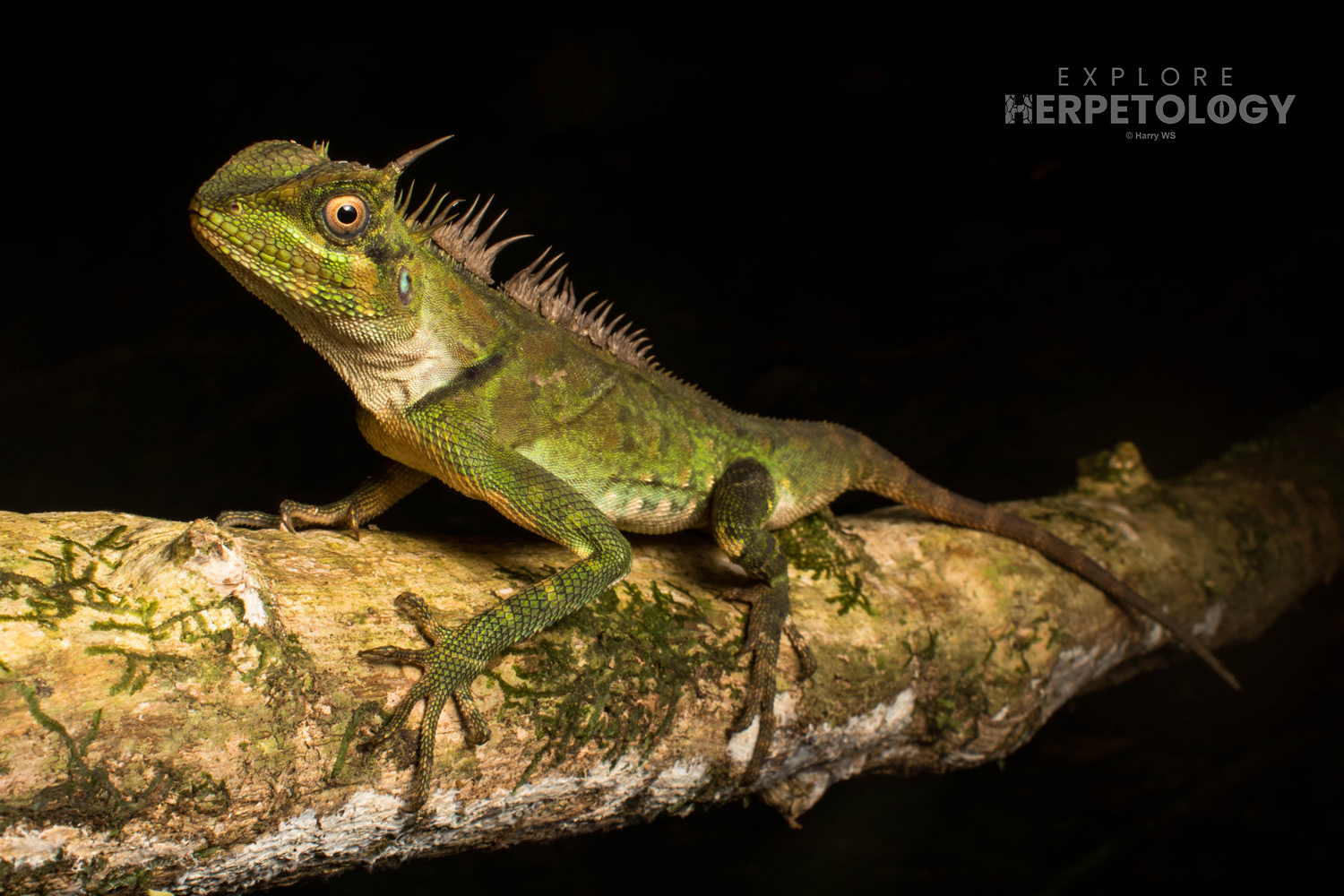
Armoured horned dragon (Acanthosaura armata)
After an intense 5 days of (highly successful) herping in Narathiwat, we drove a few hours north to cool down at a much more relaxed location. The main target here was cave racers (Elaphe taeniura ridleyi), and our trusty cave where we regularly find these delivered once more with two beautiful individuals.

Ridley's cave racer (Elaphe taeniura ridleyi) in-situ
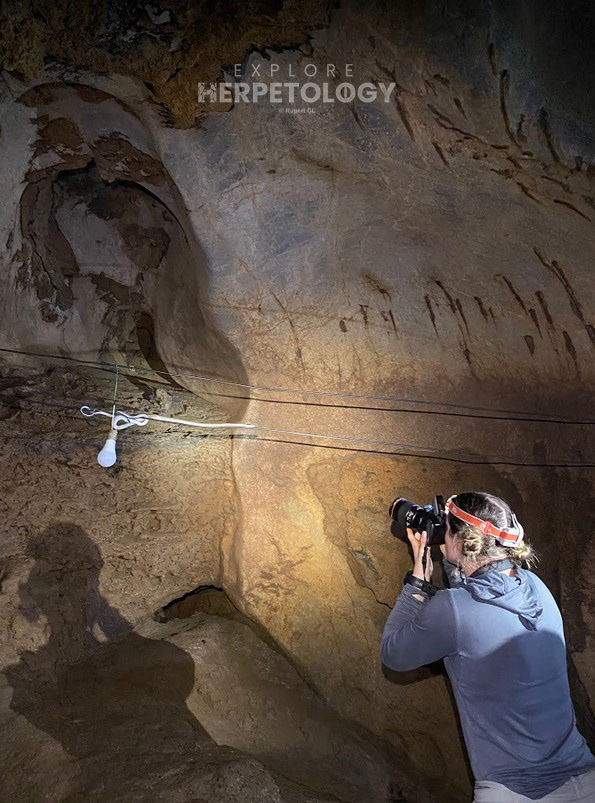
Another Ridley's cave racer (Elaphe taeniura ridleyi) in-situ.
We found several repeat species this night, including a few Martaban mud snakes (Homalopsis semizonata), 2 striped bronzebacks (Dendrelaphis caudolineatus), an elegant bronzeback (Dendrelaphis formosus) and a northern morph sunbeam snake (Xenopeltis unicolor).

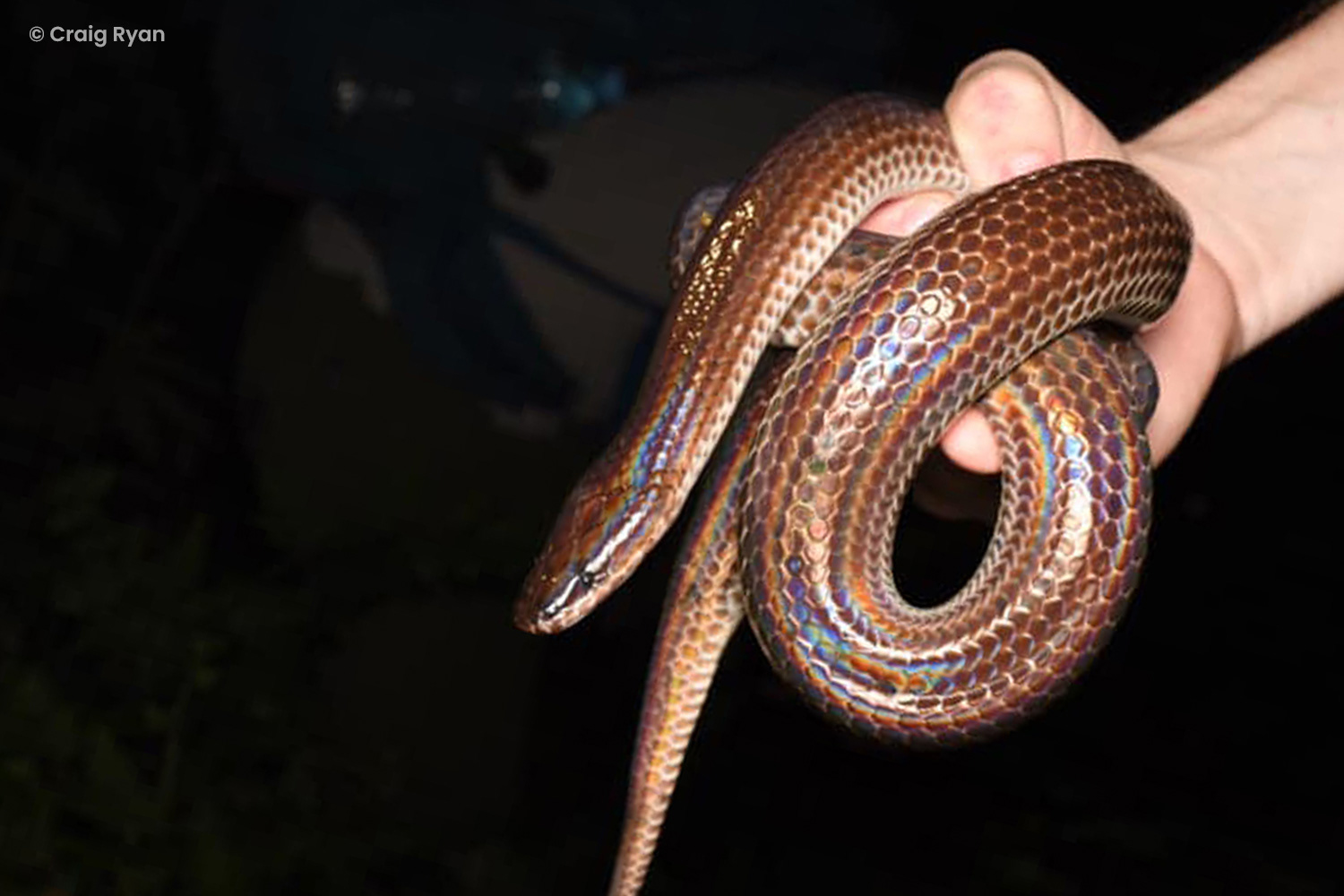
We also got three further new species for the trip, a speckle-headed vine snake (Ahaetulla fasciolata), a red-necked keelback (Rhabdophis siamensis) and lastly a Malayan bridle snake (Lycodon subannulatus).
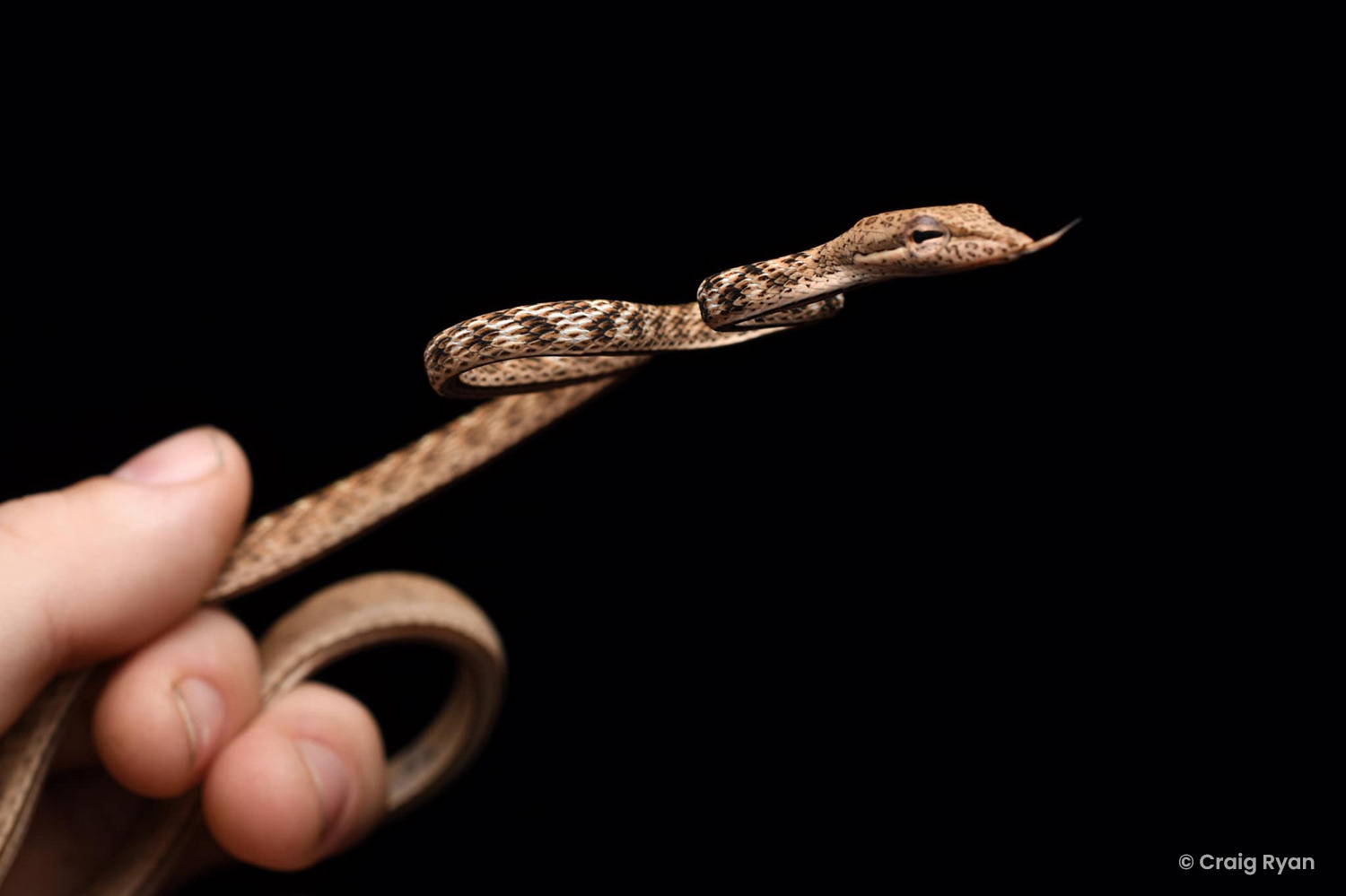
Speckle-headed vine snake (Ahaetulla fasciolata).
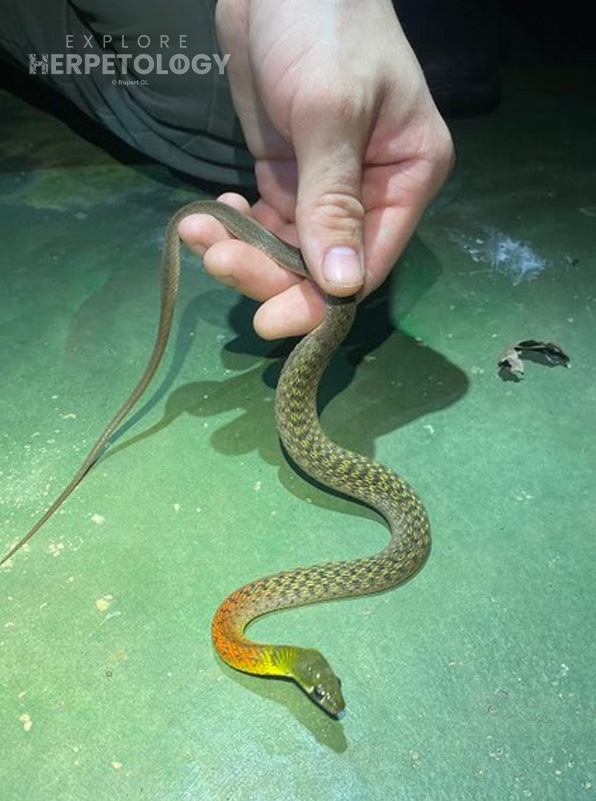
Red-necked keelback (Rhabdophis siamensis).

Malayan bridle snake (Lycodon subannulatus).
This solidified us smashing our record for most species on any field trip in 2022, despite doing shorter nights than we typically have at these locations in the past. Favorable weather conditions and our experience in the area likely played a large part, but the enthusiasm from our guests driving us to search as hard as possible should not be understated. We totaled 36 species of snake (our previous record was 33) and a minimum of 86 herpetofauna species in 7 nights.
Complete Species List of the trip:
*Note: Species may appear in this list but not the above report if individuals were not photographed or observations were fleeting.
Snakes:
Ahaetulla fasciolata
Ahaetulla mycterizans
Ahaetulla prasina
Aplopeltura boa
Asthenodipsas malaccanus
Boiga bengkuluensis
Boiga cynodon
Boiga drapiezii
Boiga melanota
Boiga nigriceps
Calliophis bivirgatus
Calliophis intestinalis
Coelognathus flavolineatus
Craspedocephalus wiroti
Cylindrophis jodiae
Dendrelaphis caudolineatus
Dendrelaphis formosus
Dendrelaphis hassi
Elaphe taeniura
Gonyosoma oxycephalum
Homalopsis buccata
Lycodon albofuscus
Lycodon effreanis
Lycodon subannulatus
Lycodon subcinctus
Oligodon signatus
Pareas carinatus
Pseudorabdion longiceps
Ptyas fusca
Rhabdophis flaviceps
Rhabdophis siamensis
Trimeresurus hageni
Trimeresurus sumatranus
Trimeresurus sabahi
Xenochrophis trianguligerus
Xenopeltis unicolor
Lizards:
Acanthosaura armata
Acanthosaura meridiona
Aphaniotis fusca
Bronchocela cristatella
Calotes emma
Calotes versicolor
Cyrtodactylus consobrinus
Cyrtodactylus lekaguli
Cyrtodactylus quadrivirgatus
Cyrtodactylus zebraicus
Draco blanfordii
Draco maximus
Eutropis macularia
Gecko cicakterbang
Gekko gecko
Gekko hulk
Gecko kuhli
Gekko monarchus
Gehyra mutilata
Gonocephalus bellii
Gonocephalus grandis
Hemidactylus frenatus
Varanus nebulosus
Varanus salvator
Amphibians:
Amolops larutensis
Chalcorana eschatia
Chalcorana labialis
Ichthyophis cf. supachaii
Ingerophrynus parvus
Kaloula latidisca
Leptobrachium hendricksoni
Limnonectes blythii
Limnonectes khasiense
Microhyla berdmorei
Microhyla heymonsi
Microhyla butleri
Occidozyga martensii
Odorrana hosii
Pelobatrachus nasuta
Phrynoidis asper
Polypedates leucomystax
Polypedates discantus
Pulchrana laterimaculata
Pulchrana glandulosa
Sylvirana nigrovittata
Xenophrys aceras
Amphibians:
Siebenrockiella crassicollis



